This article is controversial, but it will help you choose the best standing desk. Let’s face it, most reviews are full of BS. They are either fake or incentivised.
The reviewers don’t tell you that their recommendations are determined by the commission they get from the manufacturer.
The higher the commission, the more glowing the endorsement.
Worse, most reviewers have never even seen the desks in person. They’ve simply scraped their “best standing desk reviews” from the Internet using ChatGPT.
I’m here to fix all that:
- I’ll be transparent about which standing desk brands I have commercial relationships with.
- I’ve personally assembled and tested most of the standing desks in my home office.
With that in mind, I present you with the best standing desks in Australia. Drum roll, please.
The best Standing Desks In Australia For 2025 Are:
- UpDown Pro+^*, UpDown KLIK^* [tie] – best overall premium standing desks.
- Desky Dual^*, Stand Desk Pro^* [tie] – best alternatives to UpDown.
- 9am Home Atom Pro^*, 9am Home Robin Pro^* [tie] – best for design-conscious folks.
- Artiss^* – best if your budget is less than $350.
- Stando Pulse^ – best if you’re allergic to cable clutter.
- Secretlab Magnus Pro^ – great standing desk for young men.
- Stilford Lectern^ – great if you live in a tiny apartment.
- Steelcase Migration SE Pro – stylish (but expensive) desk.
- Recess, Flexispot E7-Pro, Omnidesk Ascent^ – good premium standing desks (with issues you need to know about).
* Indicates that I have a commercial relationship with the brand. I will receive a commission if you buy the desk through links on this page. ^ Indicates that I have personally assembled and tested the standing desk in my home office.
Before I unpack each desk in detail, here are my controversial discoveries that standing desk manufacturers don’t want you to know:
1. Most Standing Desks In Australia Are Almost Identical.
Premium desks (over $1,000) often share the same frames, controllers, and actuators. They’re rebranded marketed by dozens of retailers, but are built by 3-5 wholesale manufacturers.
2. Don’t Agonise Over Your Decision.
People waste months trying to find the best standing desk. Often, this is a form of procrastination. The law of diminishing returns is real. You have a job to do. Your desk is a means to that end – not the end. You can buy any premium desk (ranked #1 and #2 below) and you’ll be very happy – because of what I said in #1.
3. Differences Are Largely Insignificant.
Each premium brand has minor strengths and weaknesses, but these are largely insignificant in the context of everyday use for 90% of buyers. I’ll unpack them in detail below.
Important!
Wondering why my conclusions differ so much from other reviews? Scroll down to Why Did I Write This Review – and see why I’m not your typical “standing desk reviewer”.
1. UpDown Pro+ & KLIK [tie].
Best overall premium standing desks in Australia.
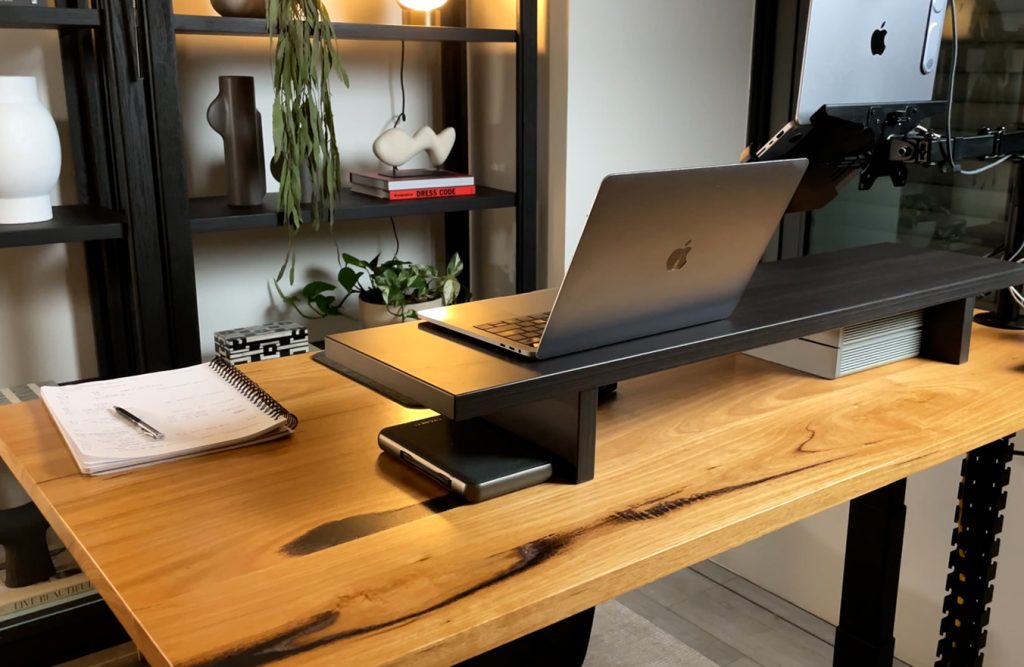
Above: The UpDown Pro+ standing desk with New Messmate desktop, plus a few accessories.
The UpDown Pro Standing Desk held my award of Australia’s best standing desk for four consecutive years.
Until the UpDown KLIK arrived on Australian shores in early 2025.
Why?
I’ll explain all the important differences between them in a moment.
But what they have in common are strong core credentials: rock-solid frames, a 100-day money-back guarantee and a huge selection of desktops.
In late 2025, UpDown upped its game once again, upgrading the already impressive Pro to Pro+ spec.
The Pro+ fixed two of UpDown’s biggest issues – the outdated height controller and a slow height adjustment speed.
Reasons To Buy & Avoid The UpDown Pro+ & KLIK.
- 100-day money back guarantee (with downsides – see below).
- Solid steel frames with very little wobble (note: all desks wobble a little – even the best ones).
- Huge selection of melamine, bamboo and hardwood desktops.
- Every feature you’d expect in a premium desk – anti-collision, presets, child lock.
- Fast delivery Australia-wide (from an Australian warehouse).
- Responsive, friendly customer support.
- 100-day money back guarantee doesn’t cover shipping in either direction.
- 75cm desktop depth may be too bulky in small apartments.
- Not cheap!
Who Should Buy The UpDown Pro+ & KLIK?
- Hybrid/WFH workers who want a reliable, premium standing desk that will last a lifetime.
- Entrepreneurs, solopreneurs and freelancers who want to create a drool-worthy home office.
- Videographers, photographers and YouTubers who plan to load the desk with a lot of gear.
- People who appreciate high-quality products.
- People on a shoestring budget (less than $900).
- Gamers (although UpDown does sell a version of the desk with a gaming look).
- Infrequent users.
Specifications.
UpDown Pro+:
- Load Capacity: 150 kg (dynamic load)
- Desktop Sizes: 180/150/120 cm (W) x 75 cm (D)
- Extension Height: 61.5 cm – 127 cm
- Warranty: 10 years on frame, 5 years on desktop
- Money-back guarantee: 100 days
UpDown KLIK:
- Load Capacity: 160 kg (dynamic load)
- Desktop Sizes: 180/150/120 cm (W) x 75 cm (D)
- Extension Height: 61 cm – 126 cm
- Warranty: 10 years on frame, 5 years on desktop
- Money-back guarantee: 100 days
Today’s Best Deals.
➤ UpDown: Black Friday Deal: Save Up To $550.
Pros.
Both the Pro+ and the KLIK are available in 16 desktop options.
You get the budget-friendly Bamboo, hard-wearing Melamine and premium hardwood Messmate, Rubberwood and Acacia.
By the way, do you want a deep dive on a specific desk? I’ve reviewed each one in detail – check them out here:
Not only is hardwood beautiful to the eye and feels nice to touch, but at 27mm, UpDown’s desktops are 2mm thicker than the competition, which amplifies the desks’ rock-solid, quality feel.
While hardwood is excellent for creating stunning (but expensive) home offices, budget office fitouts require a more pragmatic approach.
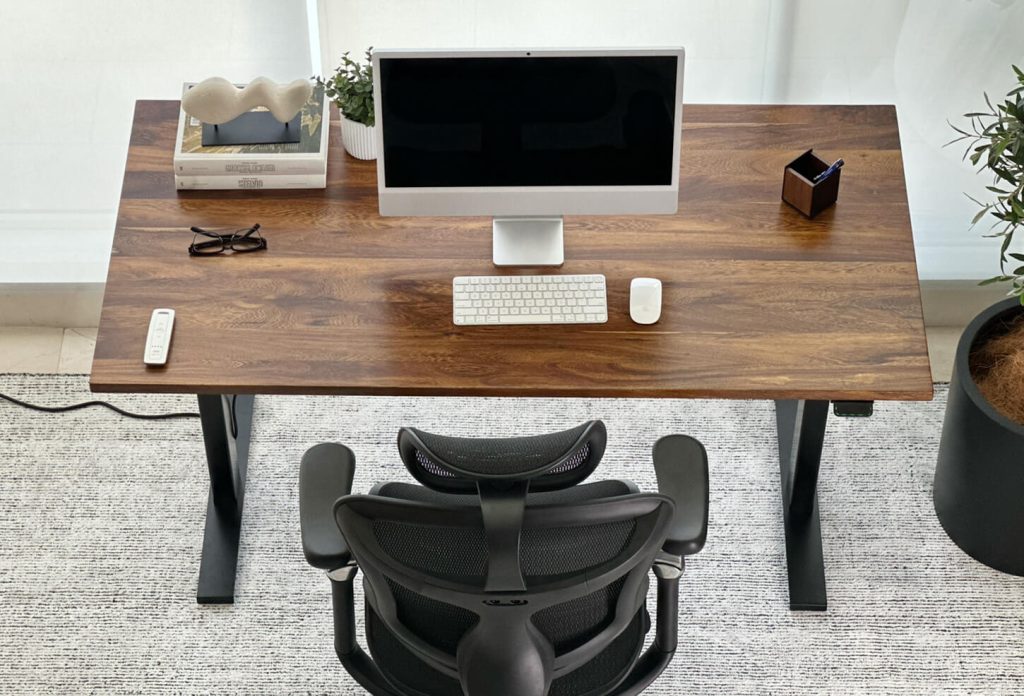
Above: The UpDown KLIK standing desk has a less heavy and more elegant-looking frame.
This is where UpDown’s Bamboo and Melamine desktop options become your best friend. Inexpensive and hard-wearing, they’re excellent for keeping the price closer to $1,000.
Important!
I love that UpDown Desk offers a 100-day money-back guarantee on all its Pro+ and KLIK series electric standing desks. The company will accept the desk back within 100 days of purchase. But there is a small catch (see below).
The best feature of both the UpDown Pro+ and KLIK stand-up desks is their bulletproof feel:
- Sitting height (~ 80 cm): The desks feel exactly like fixed-height computer desks or dining tables do. Zero wobble.
- Standing height (~100 cm): Minimal wobble – on par with all other premium desks on the market.
Extending the desks closer to 120 cm reveals some (predominantly side-to-side) wobble, but this is expected.
Did you Know?
Even the best standing desks wobble near their tallest heights due to (necessary) gaps between leg sections.
The powder coating layer is more matte than the competitors’, which I like. Shiny finishes scream “cheap” to me.
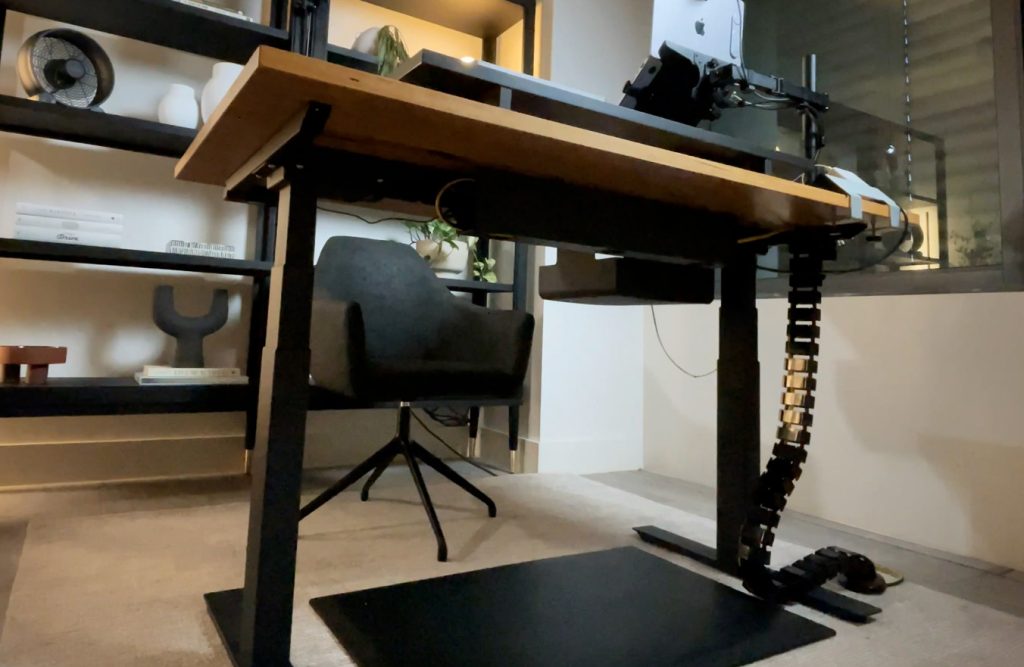
Above: The UpDown Pro+ sit-stand desk has a chunky, heavy frame with dual motors.
Both desks are packed with features you’d expect to see in a premium standing desk:
- Anti-collision sensor.
- 4 programmable heights.
- Fast movement speed (40 and 38 mm/sec for Pro and KLIK, respectively).
- Detailed assembly manuals (with video and PDF).
Important!
UpDown includes shipping protection at no extra charge to you. Desky, meanwhile, adds on about $10-$30 at checkout. This is a cheeky practice as Australian consumer laws are notoriously strict – and protect you if your desk arrives damaged or doesn’t arrive. The retailer is responsible for getting your desk to you safely, not you.
Customer reviews praise the company for its friendly service, fast shipping, and responsive customer support.
Shipping, meanwhile, is a predictable $49.90 flat fee – regardless of where you are in Australia.

Above: The KLIK with a 150 x 75 cm Pheasantwood desktop. Ample space for all your hardware, accessories, and stationery.
If you fancy yourself a standing desk nerd (fist bump), you probably know that I’ve been complaining about UpDown’s cable management system for years.
This has been the desk’s main Achilles’ heel.
Compared with Desky’s fancy integrated cable management channel (see below), UpDown’s standard cable tray has been a disappointment.
UpDown designed and launched its own under-desk cable management system.
You can now spec your UpDown with a kick-ass, generously long, integrated cable management channel.
The tray mounts up to 8 externally-facing power points and is hinged on the rear for easy access.
Why is this important?

Above: I highly recommend adding this tray as an option when placing your order.
If you’re asking this question, I envy you.
You’ve clearly never spent 20 minutes under your desk with a torch in your mouth, rummaging through a spiderweb of cables inside a tiny cable tray – just to unplug something.
Finally, UpDown’s new height controller is excellent. The company unveiled it in October as part of the upgrade of the desk from Pro to Pro+.
You get a giant, modern-looking OLED display, the usual four height presets and a button that reminds you to stand up.
While Desky’s square controller design has a more contemporary look, UpDown’s tapered edges are less likely to jam into your desk or thighs while you’re sitting down.

Above: The UpDown Pro+’s new controller has an excellent OLED display. A USB-C charging port is a nice bonus.
Cons.
When I first wrote this review back in 2021, UpDown didn’t offer pre-drilled holes in the desktops. You had to drill your own holes, and it was a major PITA.
The company addressed this issue in early 2025.
All desks now come with threaded inserts for attaching the desktop and pilot holes for attaching the controller.
Unfortunately, the fancy cable management tray I mentioned earlier still attaches to the KLIK using old-fashioned wood screws.
If I had to get very, very picky, I’d point out that three desktop widths (120, 150, and 180 cm) are available, but only one depth (75 cm).
What Size Desktop Is Best?
In my personal experience, the 150 X 75 cm desktop offers the best balance between usability and bulk – if you’re using a spare bedroom of a suburban home as your home office.
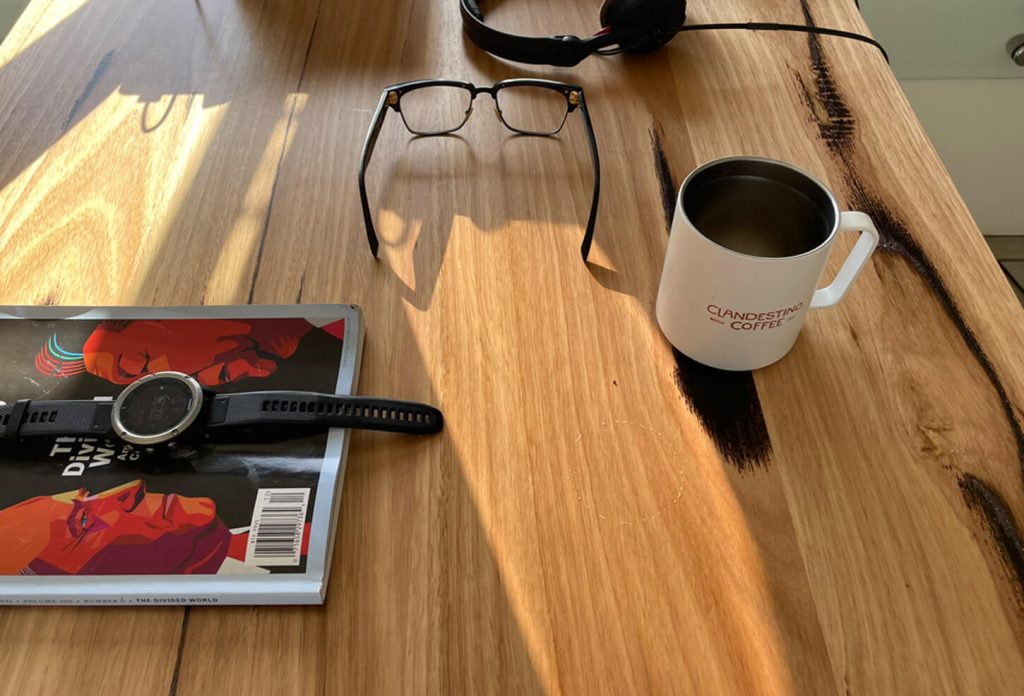
Above: Streaks of morning sunlight look glorious on my UpDown Pro’s Recycled Messmate desktop.
But if you live in a modest inner-city apartment, your spare room may not be able to accommodate such a deep desktop.
Double-check to ensure you have enough space.
Previously, the company covered shipping both ways, whereas now you’ll need to pay two lots of $49.90 to cover shipping in both directions.
The good news is that they’ve also recently partnered with two furniture retailers (one in Hawthorn, Melbourne and the other in Dee Why, Sydney), where you can view the desk in person.
Expert Tip.
Stand Desk currently has the most generous trial conditions. It’s also the youngest and smallest company among the frontrunners, so it makes sense that they’re willing to offer the least risky terms to potential customers.
Finally, the Pro+’s height range is 64-129 cm, skewing towards the upper end. This will cover 95% of the population.
However, if you’re very short (~ 155 cm), the KLIK or a Desky Dual will be a better fit.
The table below illustrates my point nicely:
| Standing Desk | Minimum Height (cm) | Maximum Height (cm) |
|---|---|---|
| UpDown Pro+ | 64 | 129 |
| UpDown KLIK | 61 | 126 |
| Desky Dual | 60 | 125 |
| Omnidesk Ascent | 60 | 125 |
| Flexispot E7-Pro | 63.5 | 128.5 |
| Secretlab Magnus Pro | 65 | 125 |
| Stando Pulse | 69 | 130 |
| Recess | 65 | 130 |
| Stand Desk Pro | 64 | 128 |
| Artiss Dual Motor | 70 | 120 |
| Stilford Lectern | 75 | 115 |
| 9am Home Robin Pro | 65 | 130 |
| 9am Home Atom Pro | 65 | 130 |
What If You Have A Small Office?
UpDown will happily create a custom desktop size (unfortunately, this voids the 100-day money-back guarantee). Alternatively, Desky offers a “Mini” premium desk in 50 and 60 cm depths. More on this later.
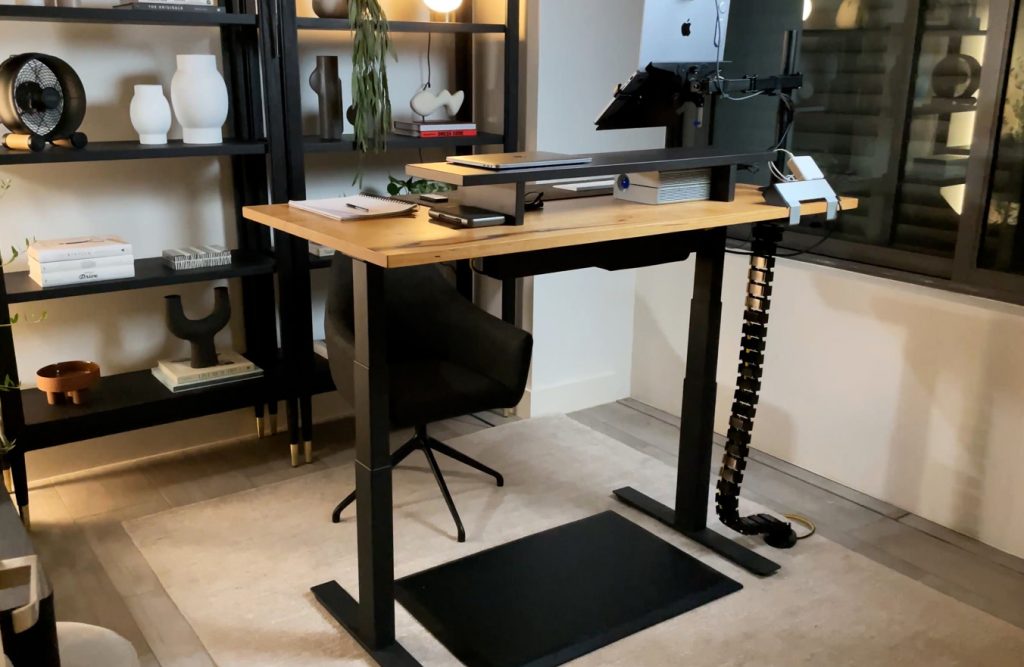
Above: My 150 x 75 cm UpDown Pro+ in standing position. Perfect workspace size for one person, but the desk eats into a significant portion of the small room.
Expert Tip.
If you live around Melbourne, UpDown can assemble your new standing desk for $149.
Verdict.
| How Do The UpDown Pro+ And KLIK Stack Up? | Score |
|---|---|
| Price | 5/5 |
| Build Quality | 5/5 |
| Aesthetics | 5/5 |
| Cable Management | 5/5 |
| Ease of Assembly | 4/5 |
| Extra Features | 4/5 |
| Warranties & Returns | 5/5 |
| OVERALL | 4.8/5 |
We are well into 2025, and the UpDown Pro+ and KLIK tie in the #1 spot as the best sit-stand desks in Australia.
These desks are for people who want the highest quality – and are willing to pay for it.
Choose a Pro+ or a KLIK, and that will be the last electric standing desk you’ll ever need to buy.
If you have the budget and enjoy solid hardwood furniture, choose a hardwood Messmate or Pheasantwood desktop. You won’t regret it.
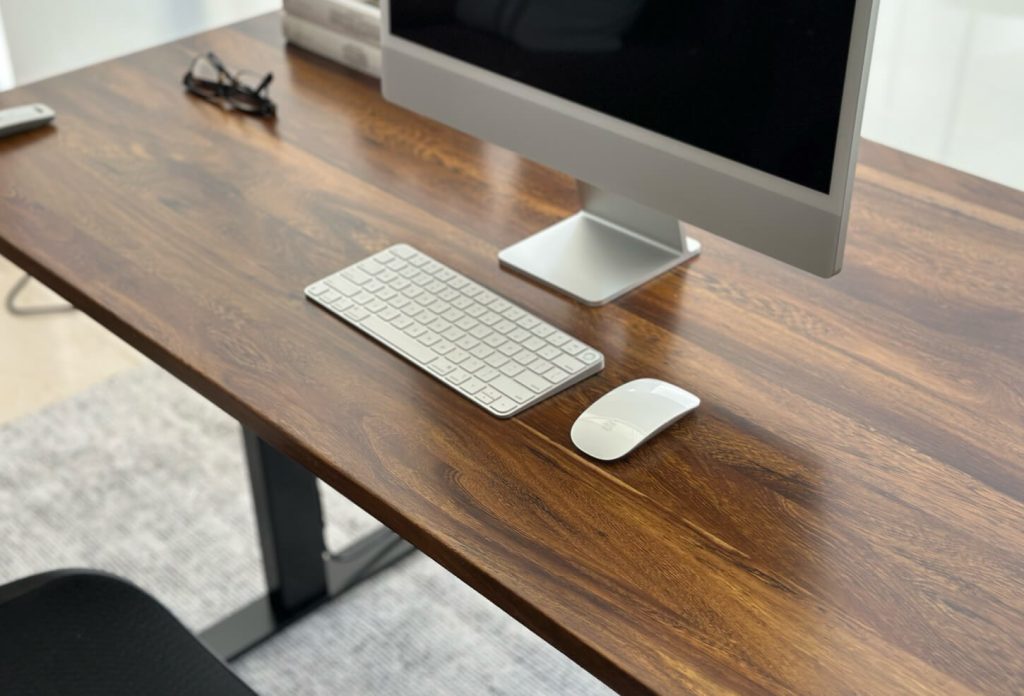
Above: The Pheasantwood hardwood desktop is particularly pretty when paired with modern furniture and devices.
What’s The Cost Of The UpDown Pro+ and KLIK?
The UpDown Pro+ and KLIK series are priced on par with other premium standing desks on the market. The KLIK is about $75 more expensive than the Pro+, but this is not a significant difference.
As a guide, prices start at just over $900 for a desk with a Melamine desktop.
Expect to pay about $1,100 by the time you add a standing mat and a drawer – both of which I highly recommend.
You’ll pay between $1,500 and $2,000 for a fully-featured hardwood desktop model.
2. Desky Dual, Stand Desk Pro [tie].
Best premium alternatives to UpDown.

Above: Desky Dual with a bamboo desktop. It’s a very handsome desk, and I love the darkened accents on the rear edge.
These desks tied for second place because they’re almost identical.
Don’t believe me?
You may be surprised to learn that many standing desk brands share components.
Important!
Desky and Stand Desk source frames, controllers and actuators from the same wholesale supplier (Jiecang). UpDown, meanwhile, uses a European supplier.
This is why I recommend that you don’t overthink your decision. The differences are mainly in branding, desktop choices, colour choices and inclusions.
Reasons To Buy & Avoid The Desky Dual and Stand Desk Pro.
- Desky offers the widest selection of desktop materials, including hardwod, bamboo and melamine. It’s slightly better than UpDown’s.
- Stand Desk offers the sharpest pricing and the best 100-day risk-free trial. The company will cover 100% of shipping costs, both ways.
- Desky has showrooms or retail partners across Australia, where you can physically view their desks.
- Heavy-duty frames and controllers supplied by the same manufacturer, Jiecang. They’re Chinese-made, but the quality is excellent.
- Anti-collision mechanisms, height presets, dual motors and child locks are standard.
- Fast delivery Australia-wide (from an Australian warehouse).
- Responsive customer support.
- Desky doesn’t offer a 100-day money-back guarantee.
- Stand Desk is the newest company on the block (3 years in Australia, 6 years in NZ).
- Prices start at just under $1,000, which is out of reach for many budget-minded folks and students.
Who Should Buy The Desky Dual or Stand Desk Pro?
- Just about anyone who wants a premium desk and has a $900-$2,000 budget.
- E.g., corporate warriors in hybrid roles, consultants, creative professionals and developers.
- People on a limited budget (less than $900).
- Infrequent users.
Specifications.
Desky Dual:
- Load Capacity: 140 kg (dynamic load)
- Desktop Sizes: 180/150/120 cm (W) x 75 cm (D)
- Extension Height: 60 cm – 125 cm
- Warranty: 10 years on frame and electronics, 5 years on desktops
- Money-back guarantee: None
Stand Desk Pro:
- Load Capacity: 120 kg (dynamic load)
- Desktop Sizes: 180/150/120 cm (W) x 75 cm (D)
- Extension Height: 64 cm – 128 cm
- Warranty: 10 years flat
- Money-back guarantee: 100 days
Today’s Best Deals.
Pros.
Stand Desk is the only company in this review to offer a genuine 100-day risk-free trial. It covers the cost of the desk, plus shipping both ways.
Desky, meanwhile, offers a limited returns policy instead of a trial.
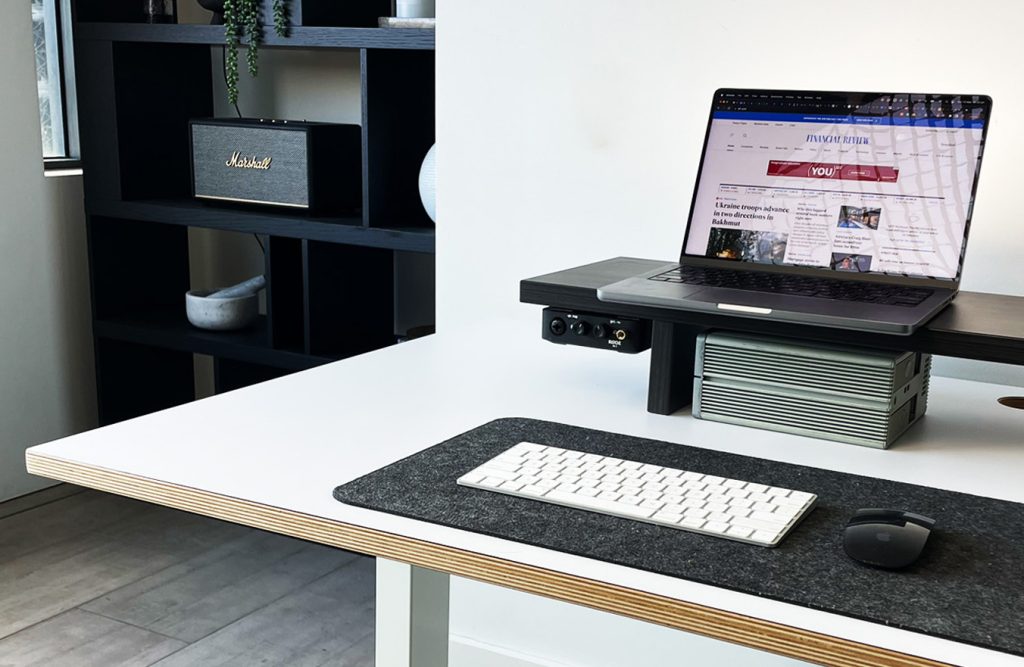
Above: Stand Desk Pro’s Birch Plywood desktop. It’s a unique look that is exclusive to this brand.
The company technically allows you to return the standing desk within 7 days of delivery, but you’ll have to pay for return shipping.
And it won’t be cheap. I compiled a few quotes to illustrate my point – see below in the 9am Home section).
Expert Tip.
In case you’re wondering, Desky has the best assembly instructions (even better than UpDown’s), with Stand Desk in second place. But it’s a minor point that shouldn’t have a huge impact on your buying decision, as you’ll (hopefully) only need to assemble your standing desk once.
This will not be a cheap exercise, as you’ll be sending a freight courier to a residential location.
Leg colour and shape are the other nuances that you may want to know about:
- Black and white are the usual choices, but Desky and Stand Desk have recently started offering grey legs.
Desky, like UpDown, offers ergo edge desktops, in which the front side has a chunk removed.
What Is An Ergo Edge Desktop?
Unlike traditional rectangular desktops, Ergo Edges have a chunk bitten out of at the front. This makes it easier for you to reach your peripherals without straining your back and neck.
Stand Desk is the only brand among the frontrunners that doesn’t allow you to view your desk in person before purchase (but remember – it has the most generous 100-day trial policy).
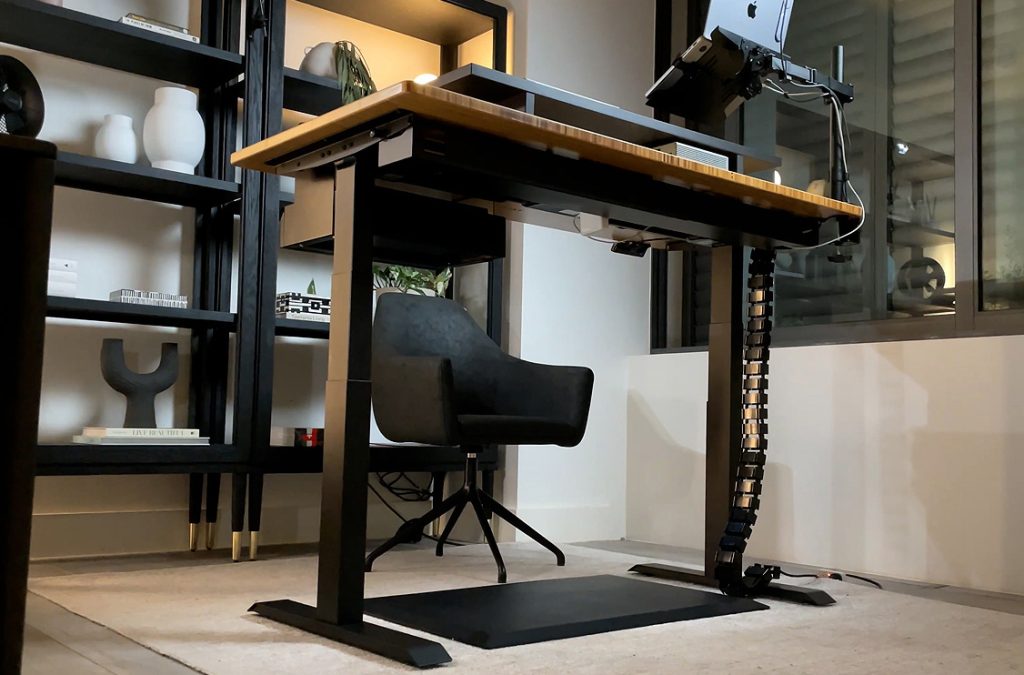
Above: My Desky Dual from a low angle, showing off the wide cable management channel and chunky legs.
Desky, meanwhile, leads the pack with 15 stockists or showrooms across NSW, QLD, WA and Victoria.
All companies, including UpDown, ship their standing desks from Australian warehouses.
While international shipping is mostly reliable, if something goes wrong, I’d rather you deal with local Australian customer support in the Australian timezone.
This doesn’t mean they are 100% insolvency-proof – but it does mitigate some risk for you as a consumer.
(Related: Stand Desk Pro Full Review: The Good, Bad & Ugly).
Buying from a younger startup means you may have nowhere to turn for warranty claims or customer support questions.
Important!
Stand Desk is the youngest company of the bunch (it’s been in Australia for 3 years and in NZ for 6), but it offers the most aggressive pricing. Its hardwood and bamboo options are about $400-500 and $100 cheaper, respectively.
The rest of the differences are minor and almost not worth mentioning.
If you’re not careful, you’ll spend weeks agonising over tiny, but ultimately inconsequential, details.
If you want to go against my advice and geek out over nuances, below is a table that compares the most important differences among all desks in this review.
| 100-Day Trial | Wireless Charger | Hardwood Desktops | Ergo Edge Desktops | Australian Warehouse? | Australian Showroom? | |
|---|---|---|---|---|---|---|
| UpDown Pro+ | Yes | No | Yes | Yes | Yes | NSW, VIC |
| UpDown KLIK | Yes | No | Yes | Yes | Yes | NSW, VIC |
| Desky Dual | No | Optional | Yes | Yes | Yes | QLD, NSW, WA, VIC |
| Omnidesk Ascent | Yes | Optional | Yes | Yes | Yes | VIC |
| Flexispot E7-Pro | No | No | No | No | No | No |
| Secretlab Magnus Pro | No | No | No | No | Yes | No |
| 9am Home Robin Pro | No | No | No | No | Yes | No |
| Recess | No | No | No | No | Yes | NSW |
| Stand Desk | Yes | Yes | Yes | No | Yes | No |
| Artiss Dual Motor | No | No | No | No | Yes | No |
| Stilford Lectern | No | No | No | No | Yes | Any Officeworks |
| 9am Home Atom Pro | No | No | Yes | No | Yes | No |
| Steelcase Migration SE Pro | No | No | No | No | Yes | NSW |
Expert Tip.
Standing desk companies offer regular promotions, making like-for-like price comparisons challenging. I suggest you ignore their listed prices and compare the final prices in shopping carts, including shipping and any bonus accessories.
By the way, Desky and UpDown are the only brands that allow you to run up to 8 X 240V power sockets directly under the desk.
This will appeal to owners of elaborate multi-device workstations who always seem to be one power socket short.
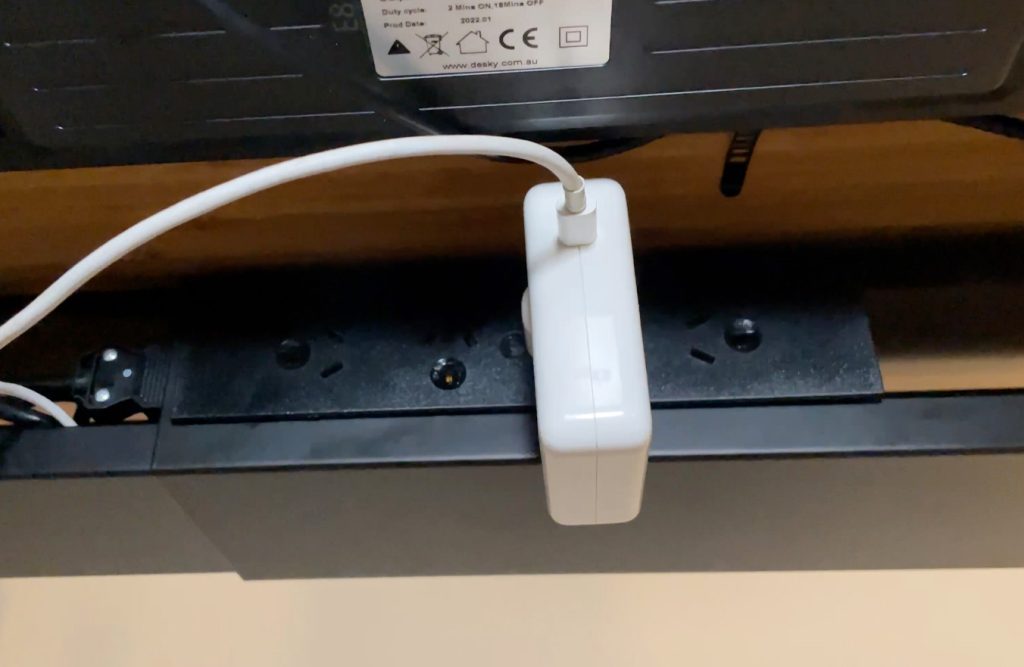
Above: Desky’s unique powerboards. Here you see my 4-socket variant.
Bamboo vs Hardwood vs Melamine Desktop: Which Is Best?
Bamboo is inexpensive and practical, yet it doesn’t look cheap. Hardwood is stylish and durable, while Melamine is cheap, hard-wearing and somewhat unexciting.
Cons.
Both of these companies produce excellent desks, so there’s little to pick at.
But I know you expect me to find something 🙂
So here goes.
My criticism of UpDown’s fixed 75 cm depth applies to this duo as well.
The deep desktop is great if you have the space, but can overpower small home offices.
Expert Tip.
Desky’s 110×60cm “Mini” fits where a 75cm-deep desk won’t, but it comes with a significant trade-off: a 41% reduction in desktop area. It’s not for people with a lot of gear.
Second, Stand Desk trails Desky when it comes to the range of desktop materials.
The former offers two hardwoods plus a handful of MDF and bamboo alternatives. The latter, meanwhile, offers over 17 bamboo, melamine, and hardwood options.
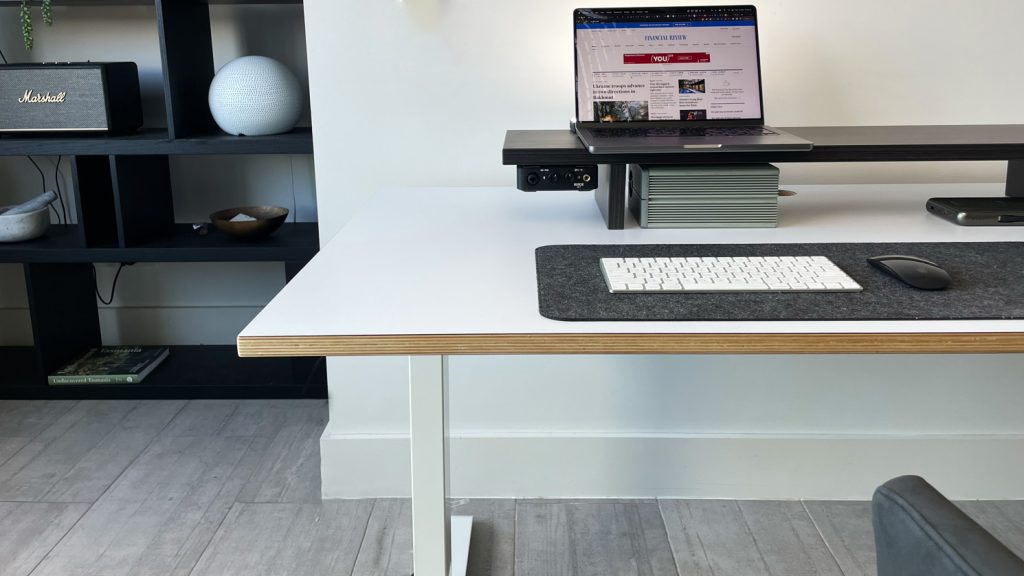
Above: Stand Desk Pro’s frame looks almost identical to Desky Dual’s. Because it is.
I’m also surprised that Desky stubbornly refuses to offer a 100-day trial period. UpDown and Stand Desk absolutely smash it on this front.
Last niggle is the price.
These are not cheap, disposable desks for university students intending to send them to the tip after graduation.
Starting at roughly ~$1,000 (see below for details), they are outside of reach for many people.
Verdict.
| How Do The Desky And Stand Desk Pro Stack Up? | Score |
|---|---|
| Price | 5 |
| Build Quality | 4.5 |
| Aesthetics | 5 |
| Cable Management | 5 |
| Ease of Assembly | 5 |
| Extra Features | 4.5 |
| Warranties & Returns | 4 |
| OVERALL | 4.7/5 |
Both of these brands offer excellent standing desks.
Even though the UpDown edges them out slightly, it’s only because of the company’s reputation for bulletproof frames and verifiable 4.9-star customer support.
But as I keep reiterating, these differences are minimal.
Did You Know?
I have a Desky Dual and an UpDown Pro+ set up in my home office side-by-side, and I often forget which one is which.
All of the premium desks (that is, desks in positions #1 and #2) are equally sturdy and wobble very little.
If you want to get very, very picky, Desky and Stand Desk’s Jiecang frames are better front-to-back stability, while the UpDown’s European frames are more stable side-to-side.
What’s The Cost Of The Desky Dual and Stand Desk Pro?
As with the UpDown Pro+ and KLIK, expect to pay about $1,000 for a desk with a 150-75 cm softwood desktop.
Hardwood options will push the price into the $1,500-$2,000 territory.
3. 9am Home Atom Pro & Robin Pro [tie].
Best standing desks for design-conscious Australians.

Above: The Robin Pro’s leg design is refreshingly different. Finally, a standing desk that doesn’t look like the rest.
My wife is used to standing desks sprouting up around our apartment.
I test each new one in the living room for a few weeks.
- (Related: 9am Home Robin Pro Full Review: Good, Bad & Ugly).
- (Related: 9am Home Atom Pro Full Review: Good, Bad & Ugly).
She rarely blinks an eyelid.
Except this time.
As soon as I finished setting up the Atom Pro, the woman swooned over it like it was Ryan Gosling in a tux.
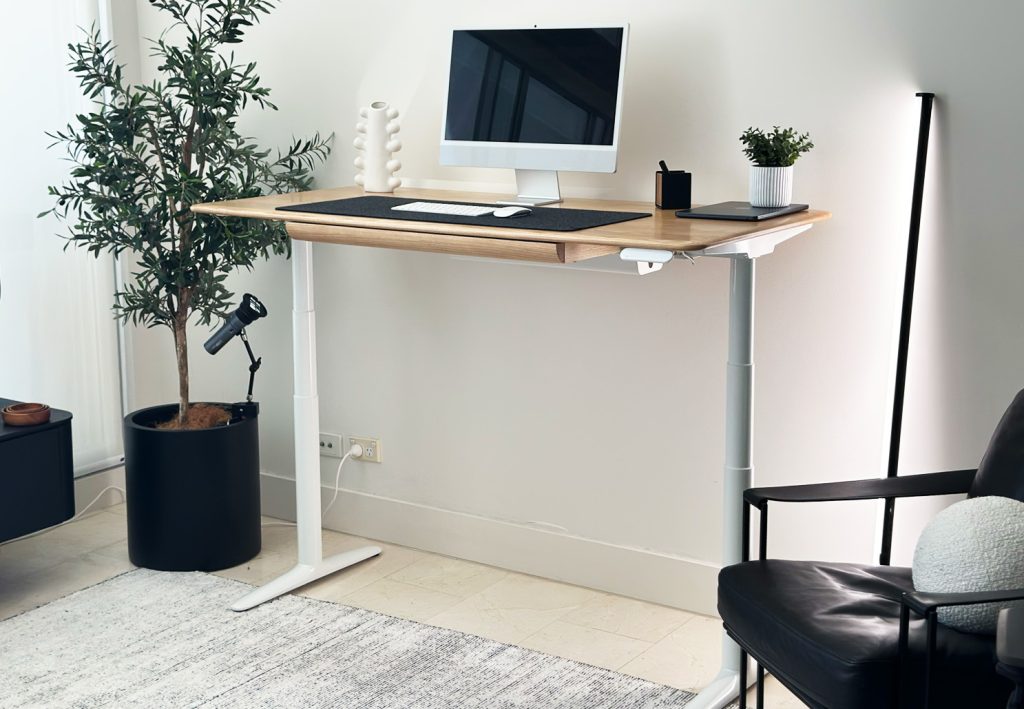
Her reaction was not accidental.
Above: The Atom Pro is Ryan-Gosling-level sexy. Apparently.
Reasons To Buy & Avoid The 9am Home Atom Pro & Robin Pro.
- Gorgeous designs that don’t look like traditional standing desks.
- Classy yet understated Scandi aesthetic.
- Apartment-friendly desktop sizes (Robin Pro).
- Arrives partially assembled (Robin Pro).
- Excellent integrated under-desk tray (Atom Pro).
- Cheap-ish controller and desktop (Robin Pro).
- Fiddly assembly process (Atom Pro).
- Can’t spec it with drawers or desktop cable management holes (Robin Pro).
- Weak money-back guarantee – and only 3 year warranty on electronics.
Who Should Buy The 9am Home Desks?
- People who have a great eye for design.
- Apartment dwellers and people with small home offices (Robin Pro).
- People who can’t stretch to a $1,100 UpDown or Desky (Robin Pro).
- People who use minimal peripherals and accessories.
- Professional videographers who need a bulletproof workhorse for multiple monitors and storage drives.
Specifications.
Atom Pro:
- Load Capacity: 125kg
- Desktop Sizes: 120x75cm, 150x75cm, 170x75cm
- Extension Height: 65-130cm
- Warranty: 10 years on frame and motors, 5 years on desktop, 3 years on electronics
- Risk-Free Trial: No.
Robin Pro:
- Load Capacity: 125kg
- Desktop Sizes: 120X60cm, 140x65cm, 160x70cm
- Extension Height: 65-130cm
- Warranty: 10 years on frame and motors, 5 years on desktop, 3 years on electronics
- Risk-Free Trial: No.
Today’s Best Deals.
➤ 9am Home: Black Friday Deals: Get Up To $400 Off.
Pros.
Unlike the masculine and industrial-looking designs from UpDown, Desky and especially Secretlab, 9am Home’s desks look unusually approachable and friendly.
I can see them appealing to design-conscious buyers who want their WFH space with a certain je ne sais quoi.
For example, health practitioners, consultants and coaches.
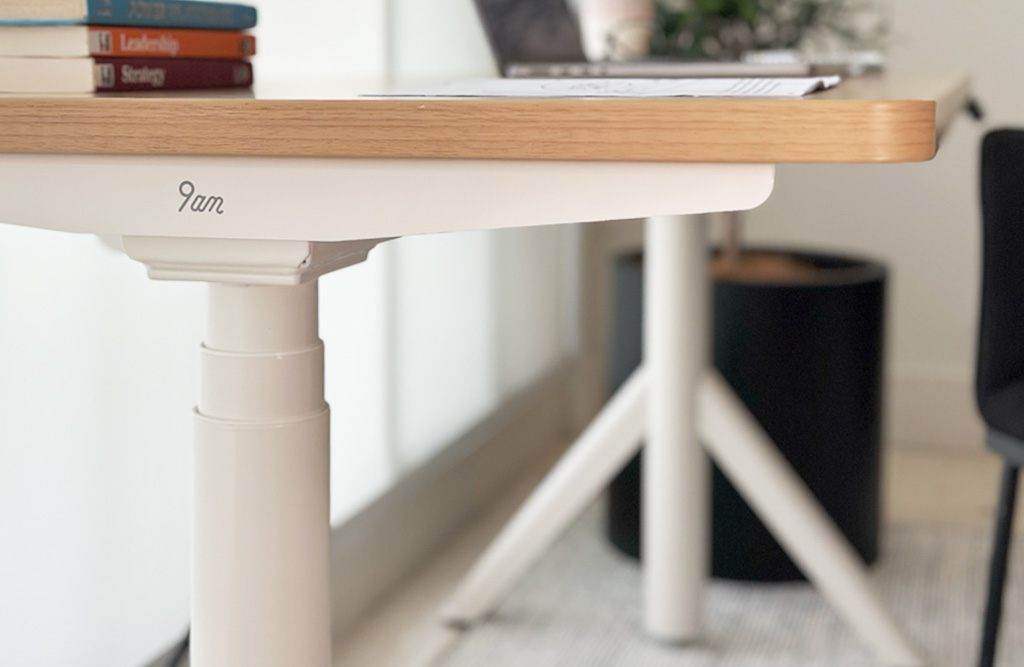
Above: Stamped logos on each side of the frame are a nice touch.
The design philosophy is centred around curvy lines, tubular legs and Scandi-inspired colour palettes.
The $1,449 Atom Pro opts for smoothly blended leg design, while the $869 Robin Pro offers a spicier “Devil’s Pitchfork” legs.
The theme continues to the desktops.
Atom Pro has a beautiful bullnose edge while the Robin Pro opts for a straight edge – albeit with rounded corners.
It’s cleverly recessed into the desktop – and completely hidden from view – unless you know it’s there.
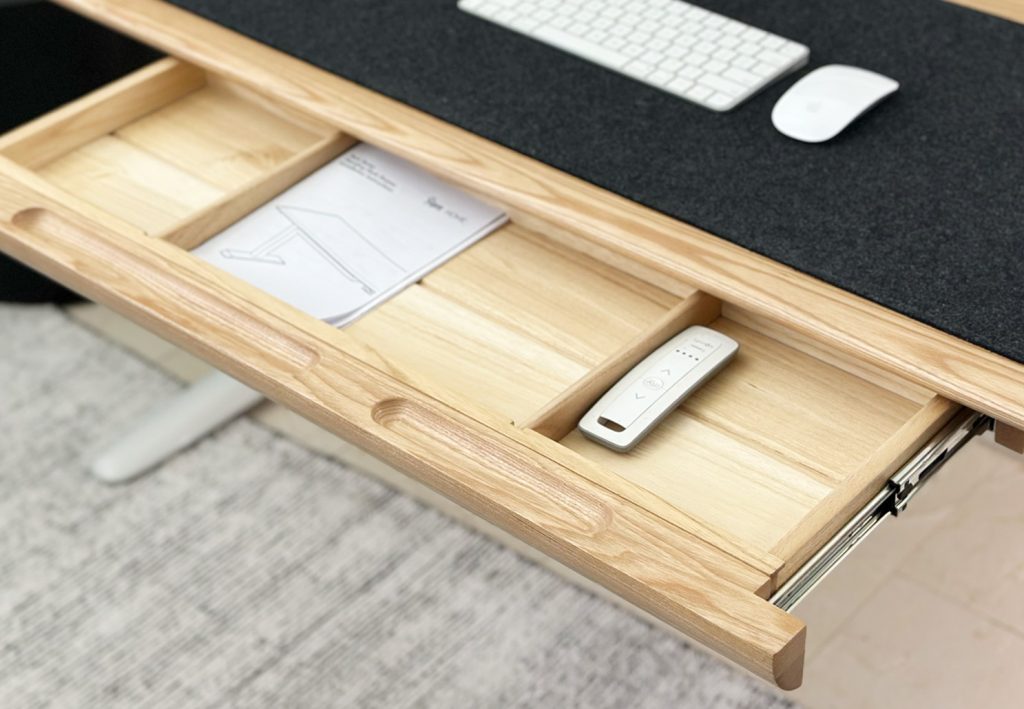
Above: Deep enough to comfortably hide your keyboard, notepad and a few pens, Atom Pro’s tray is an excellent example of design meeting function.
While UpDown and Desky insist that you hang a tray underneath like an ugly afterthought, 9am Home’s design is aesthetically superior.
It’s not deep – so don’t expect to stash chunky books into it. But it’s perfect for all the crap that clutters your desk – e.g., stationery.
The Atom Pro is definitely aimed at larger office spaces, with its constant 75 cm depth and a choice of three widths – 120, 150 and 180 cm.
Robin Pro’s desktop size choices, meanwhile, tilt towards apartment dwellers and people with small home offices.
By the way, I must highlight Robin Pro’s incredibly easy assembly. It’s the simplest desk I’ve ever put together.
Important!
The desk arrives at your door partially pre-assembled and pre-wired.
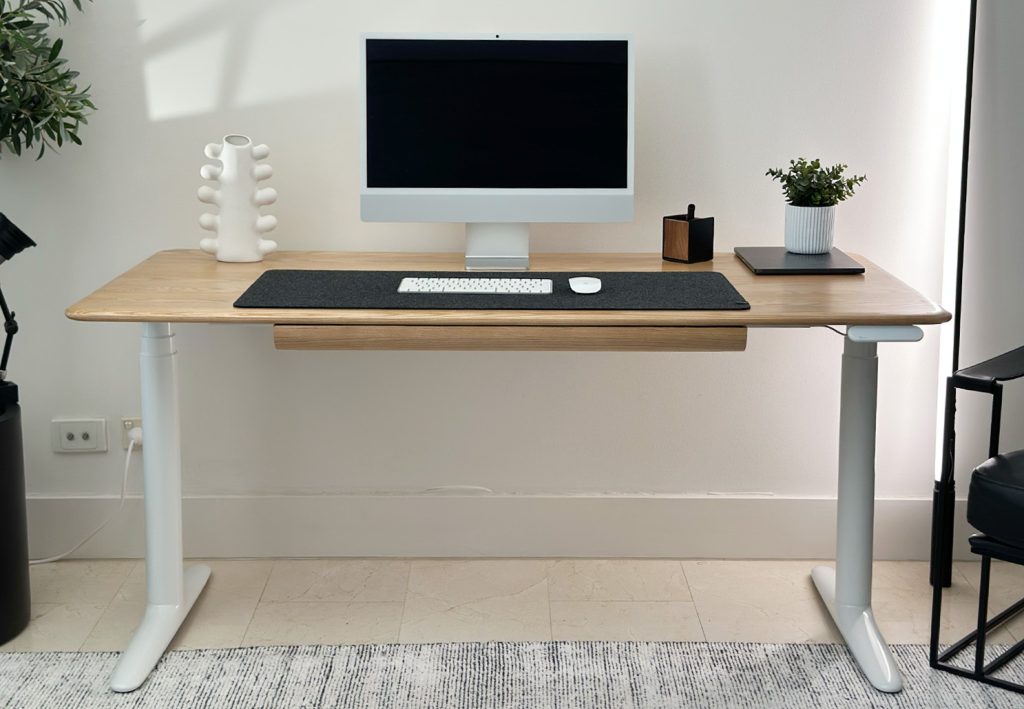
Above: The Atom Pro showing off its curved lines and under-desk tray.
While 9am Home’s “30-second” assembly claim is ambitious (I assembled it in 15-20 minutes), the Robin Pro is great for people intimidated by screwdrivers and assembly manuals.
However, in a strange plot-twist, the Atom Pro is one of the most fiddly, unpleasant desks I’ve ever had to assemble (see “Cons” below).
Build quality of both desks is top notch – but not perfect.
The Atom Pro – being the premium option – is the better-built of the two:
- American Ash desktop feels outstanding to the touch.
- Whimsical controller looks decidedly modern and expensive to the touch.
- Legs are satisfyingly thick and heavy.
- Drawer slides out without rattles or glitches.
- Motors are quiet.
The Robin Pro is also well-built, but it has a couple of annoying trade-offs in build quality that I’ll discuss in “Cons” below.
Cons.
The Atom Pro’s assembly could be a lot better.
First, I was surprised to find that it doesn’t arrive preassembled – as does the (cheaper) Robin Pro. Shouldn’t the more expensive product require less elbow grease?
Second, its manual is hard to understand and dense.
In fact, you get 3 separate manuals – one for the desk itself, one for the cable tray and one for the drawer.
Each of them tells you to flip the desk upon completion. You do it, only to realise you must flip the desk again. Gah.

Above: Robin Pro’s desktop and controller feel a bit cheap to the touch.
Third, the way the desk comes together is fiddly. You don’t get any quick-lock mechanisms – just the good ol’ fashioned bag of screws and an Allen key.
Both desks are merely good – but not outstanding – when it comes to stability.
They’re fine for normal everyday use – but people with a lot of gear (e.g., multiple monitors) will find that above 100cm extention, UpDown’s, Desky’s and Stand Desk’s desks are more sturdy.
Important!
Tubular legs are almost always a red flag for me, due to their notoriously inferior stability. 9am Home dodged stability issues by using cold (rather than hot) steel rolling process, known for producing tighter tolerances and true round shapes.
Interestingly, the Atom Pro is more stable side-to-side – while the Robin Pro is more stable back-to-front.
Finally, the 65 cm minimum height may be too tall for users who are shorter than 160 cm.
The cheaper Robin Pro must cut corners in a couple of areas to bring the price down, and they are:
- Desktop quality. It’s standard MDF fare. Nothing to get excited about, but doesn’t feel el cheapo, either.
- Controller. While the button layout is smart (I love the easy-to-find, bright green “stand” button), but the choice of plastic is disappointing. It feels like a dashboard from a 2008 Toyota Camry.
Finally, 9am Home touts its “30 Day Returns” – but they’re a bit of a gimmick.
They expect you to cover the cost of return shipping.
Which, if you’re sending from a residential Australian address, isn’t cheap.
Here are some quotes I got this morning for sending a 140x65cm Robin Pro from my home in Potts Point to 9am Home’s warehouse in Silverwater.
The same criticism applies to all other standing desk brands offering “free returns” without subsidised or free return shipping.
Looking at you, Desky.
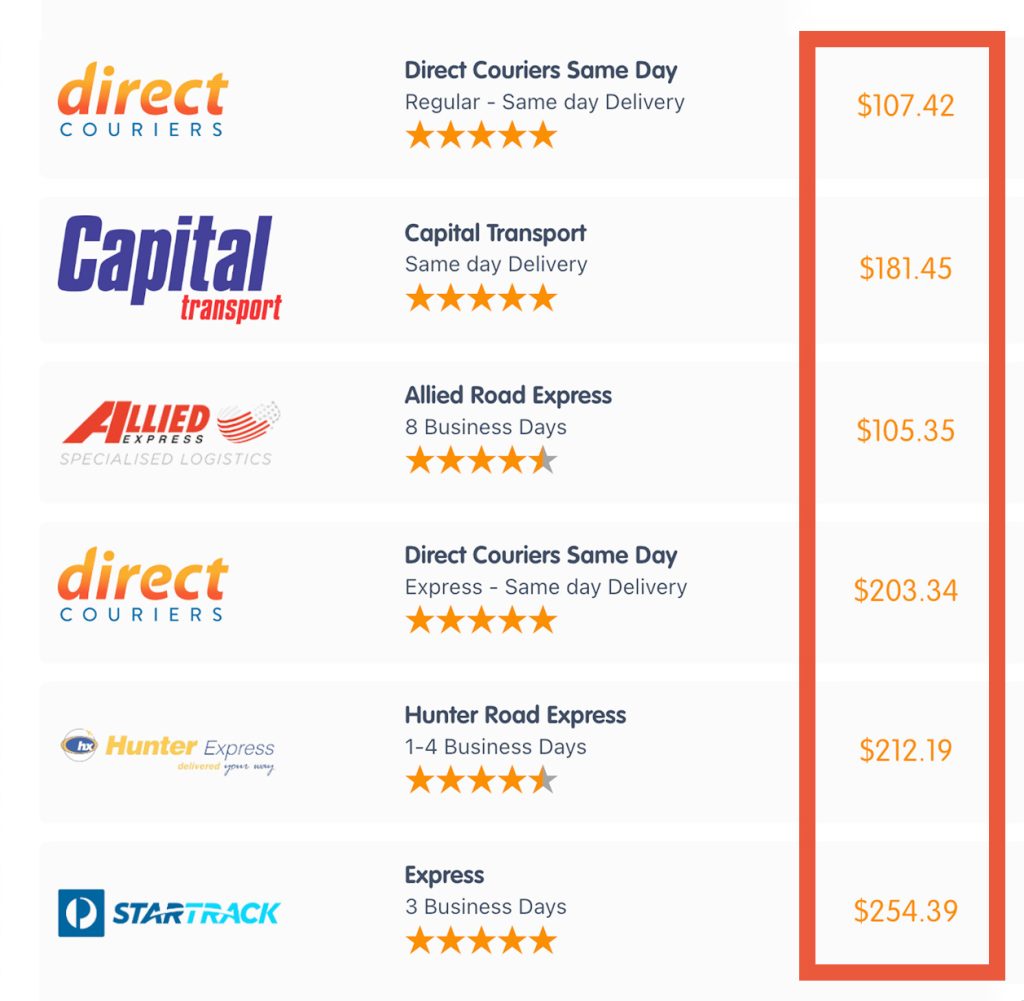
Above: Will you pay between $100 and $250 just to return your $800-1400 desk? Didn’t think so.
The “10-year warranty” also has more fine print than I’d like. It’s great that the motors are covered for 10 years. But why cover the controllers and sensors for only three?
My other gripe is that 9am Home doesn’t give you the option to accessorise your Robin Pro with a drawer, grommets or an advanced cable management system.
You’ll have to run cables off the back of the desk into the (admittedly free) under-desk cable management tray.
A drawer is a must-have, in my opinion, for maintaining a neat workspace. Unfortunately, 9am Home won’t sell you one, but there is a workaround.
You can pick one up on Amazon for about $50.
Verdict.
| How Does The Robin Pro & Atom Pro Stack Up? | Score |
|---|---|
| Price | 5/5 |
| Build Quality | 4/5 |
| Aesthetics | 5/5 |
| Cable Management | 4/5 |
| Ease of Assembly | 4/5 |
| Extra Features | 4/5 |
| Warranties & Returns | 4/5 |
| OVERALL | 4.3/5 |
The Robin Pro and Atom Pro are the best standing desks in Australia – for people want a standing desk that looks like a normal desk.
If you have roughly $1,400 to spend, the Atom Pro is a strong contender. It looks so “designer” that visitors to your WFH office will not realise it’s a standing desk.
But if you’re on a tighter budget of around $800, the Robin Pro is your pick.
Yes, they’re slightly less stable than the Goliaths (UpdDown, Desky, etc), but if you don’t plan to place huge (or multiple) monitors on them, you’ll be fine.
9am Home kept the price of the Robin Pro down by using inexpensive MDF desktops and controllers, but these are smart tradeoffs.
As the saying goes, you can’t have your cake and eat it, too.
Important!
The company didn’t compromise on the essentials – the cold-rolled steel frames and dual motors.
4. Artiss Standing Desk.
Best if your budget is between $290 and $390.
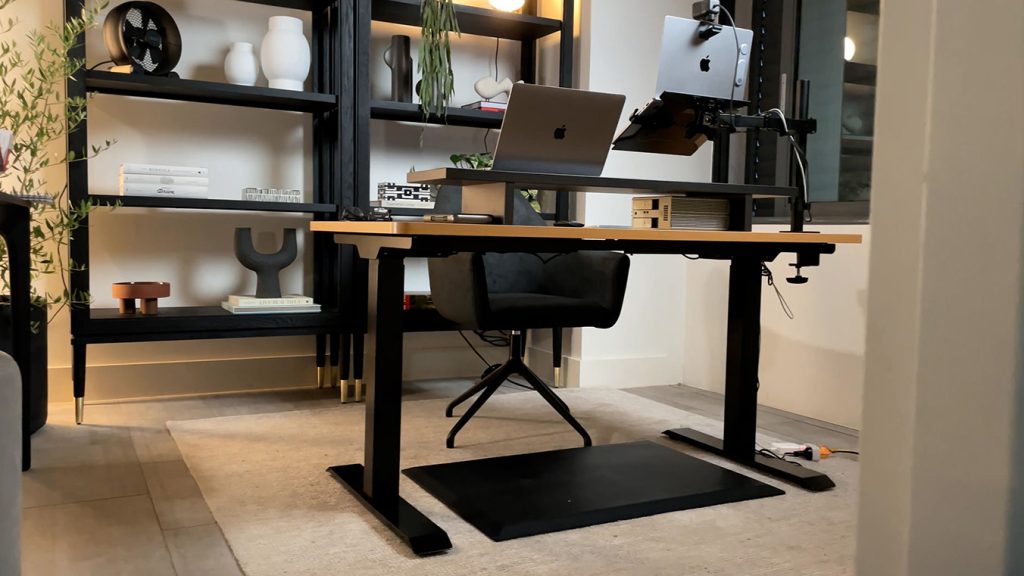
Above: Cute and compact, the Artiss sit-stand desk is in the lowered position.
The Artiss is my fourth-best standing desk in Australia because it offers a lot of value for a small price.
I had one of these desks in my home office for almost two years until I upgraded to the UpDown Pro+ series (mostly because I wanted a desk made from hardwood), and I had very few complaints about it.
(Related: Artiss Desk Full Review: The Good, Bad & Ugly).
Artiss sells two models of this standing desk. One of them is better than the other:
- Premium (about $390). Dual motors, memory presets, 100 kg lift rating.
- Base (about $290). Single motor, no memory presets, 70 kg lift rating.
Important!
Throughout this review, I’m referring to the Premium model. But if you’re on a very strict budget, the Base model is about $100 cheaper, and is your next best choice. I’ll provide links to both below.
Reasons To Buy & Avoid The Artiss.
- Cheap! Where else can you get a decent standing desk for between $260-$330, including delivery?
- Surprisingly good build quality.
- Dual motor model is available.
- Height presets and an anti-collision mechanism on the dual motor model.
- Fast delivery Australia-wide (from an Australian warehouse).
- The 120×60 cm desktop option is great for small rooms.
- Single crossover under the desk means you can’t place heavy loads on top.
- 1 year warranty is almost a joke.
- No cable management systems of any kind.
Who Should Buy The Artiss?
- People with a limited budget: students, early-stage startupistas.
- WFH workers who live in small apartments.
- People who never had a standing desk before and want to test the waters with a cheapie.
- FIRE community members.
- People looking for that “WOW” factor.
- People who need a desk with a lot of space (max desktop dimensions are 140×70).
Specifications.
- Load Capacity: 70 kg – 100 kg (dynamic load)
- Desktop Sizes: 120 x 60 cm or 140 x 70 cm
- Extension Height: 69-117 cm or 70 – 120 cm
- Warranty: 1 year
- Risk-Free Trial: Hell no.
Today’s Best Deals.
Pros.
Let’s start with simplicity. When ordering your Artiss standing desk, you only have two decisions: desktop colour and leg colour.
There’s also a choice of 120 cm and 140 cm desktop sizes, but I recommend that you automatically default to the larger 140 cm size to maximise your desk space.
Expert Tip.
The price difference between the two sizes is less than $30. Unless you have severe space constraints, you’d be mad not to order the larger one.
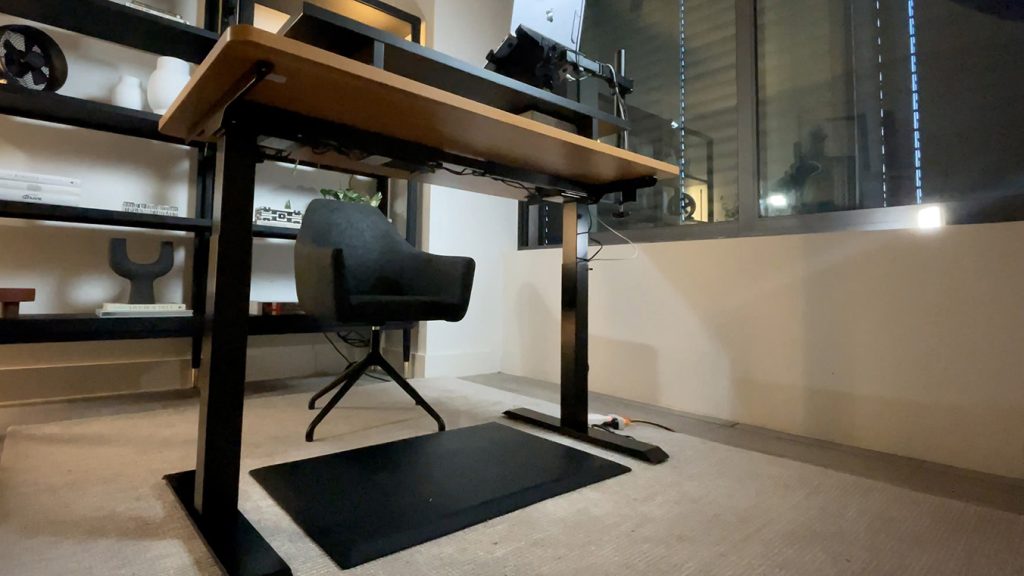
Above: Artiss’s fuss-free approach is evident here. No cable management channel and no under-desk drawers are available. Also, note the single metal cross-member. All other desks in this review have two.
This lack of complex options translates to a low price.
Because the Artiss is one of the cheapest standing desks in Australia, I was worried that its electric height adjustment controller would look and feel like a children’s toy.
In fact, the entire desk is surprisingly well-made. Yes, the desktop is not made from real wood, but it feels pretty nice to the touch.
Dual motors for $330 are a nice surprise. I can confirm that the desk moves up and down without issues, smoothly, and at a rapid clip.
And yes, the desk frame is a bit thin on metal (more about this shortly), but the Artiss is surprisingly sturdy – even at the tallest heights.
But the best feature of this desk is its price.
Expert Tip.
Depending on the model, you can have it delivered to your door for between $260-$330. That’s incredible value if all you want is a no-nonsense WFH setup.
Cons.
While the desktop material doesn’t look and feel cheap, you won’t mistake it for bamboo or solid hardwood from a premium manufacturer like UpDown or Desky.
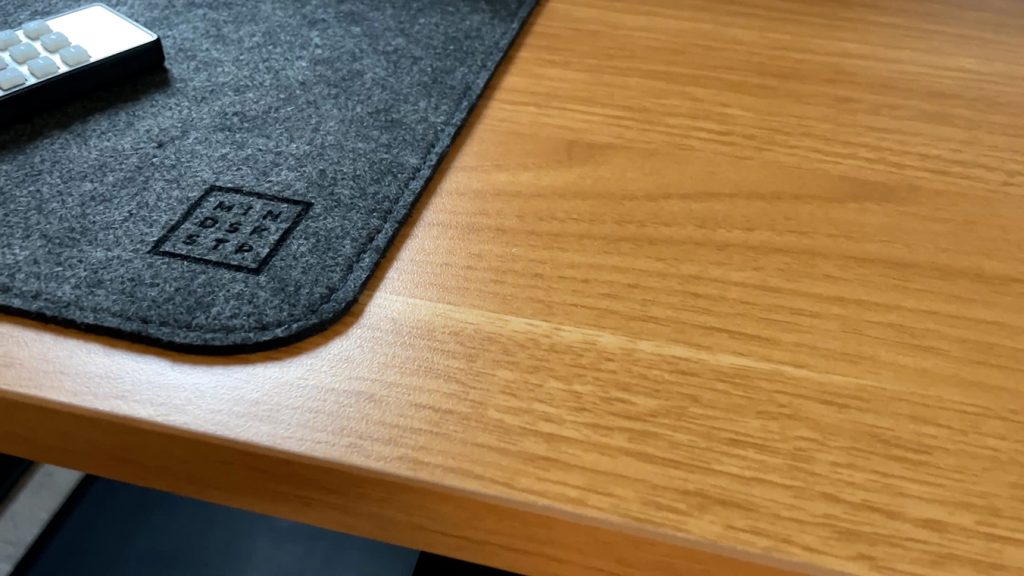
Above: Artiss’ desktop is made from a laminate that imitates the look and feel of real wood. As far as imitations go, it’s a very good one.
In my opinion, the desk’s look and feel are spot-on for this price point.
Another thing I don’t love is Artiss’s 100 kg load capacity.
While this is enough to support a couple of monitors, a computer, and your body parts’ weight, the premium desks beat this figure by over 50%, with their 120-150 kg maximum load rating.
Cable management is not even on Artiss’ radar.
You don’t get cable management channels (and can’t buy one as an option), grommets or pre-cut grooves.
But you do get a packet of cable ties, dear user.
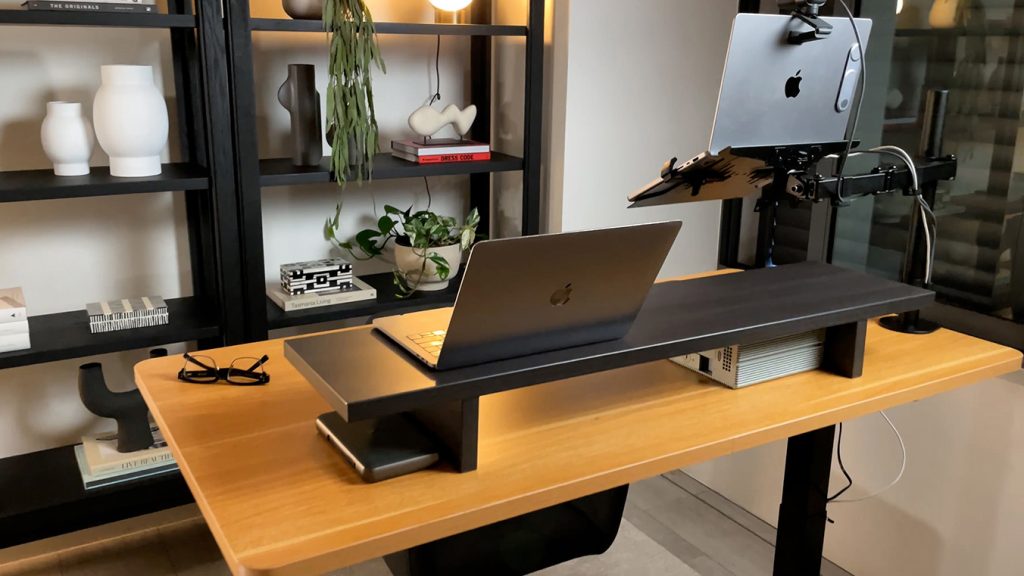
Above: 140 cm width is enough to comfortably position two laptops, but don’t expect to fit a second person here.
Finally, the desk frame itself.
It’s significantly less significant than the frames of its premium rivals.
The Artiss is the only desk here with a single cross-member in its frame, and its legs are made from thinner sheet metal.
I wouldn’t use this desk for carrying heavy-duty loads, but it’s perfectly OK for everyday tasking and emailing.
Artiss’ warranty is also lacklustre.
You get twelve months of coverage compared with 5-10 years from most other brands on this page. You don’t get a 100-day trial, either.
Important!
Context is important — you are paying about a quarter of the rivals’ price. Mine lasted for over two years without missing a beat before I sold it.
Last but not least – the Artiss’ max height is one of the lowest of all standing desks in Australia. At 117 cm (single motor) or 120 cm (dual motor), it will cater to short and regular-sized folks without issues.
People over 195 cm, however, will want extra height.
I’m 200 cm, and I’ve found that my forearms were always a tad too low.
Verdict.
| How Does The Artiss Stack Up? | Score |
|---|---|
| Price | 5/5 |
| Build Quality | 4/5 |
| Aesthetics | 3/5 |
| Cable Management | 2/5 |
| Ease of Assembly | 4/5 |
| Extra Features | 2/5 |
| Warranties & Returns | 2/5 |
| OVERALL | 3.1/5 |
As someone who has used this standing desk for almost 2 years, I know it deserves the #4 spot. It’s also better than budget Ikea options (see below) if your budget is between $290-$390.
If I had to summarise the Artiss in a single phrase, it’d be “outstanding value for money”.
What’s The Cost Of The Artiss Desk?
The Artiss stand-up desk is very well-priced. Expect to pay between $290 and $390 for this bloody bargain.
5. Stando Pulse.
Best sit-stand desk if you’re allergic to cable clutter.
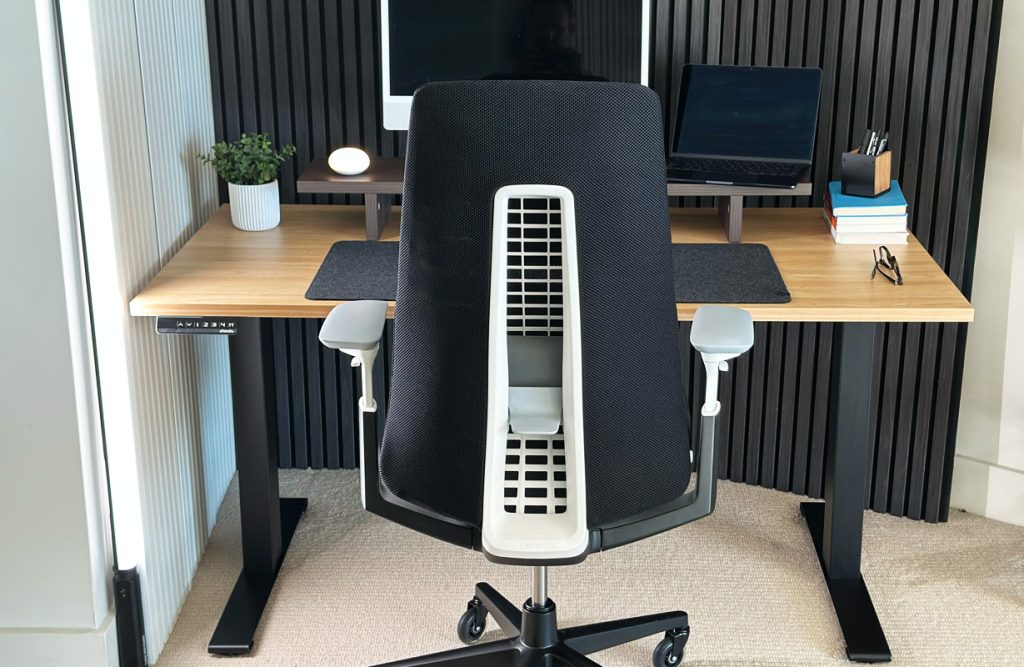
Above: The Pulse’s #1 differentiator is its built-in power cord.
At first glance, the Stando Pulse looks exactly like all the Deskys and UpDowns of this world. But look closer and you’ll spot its #1 differentiator: the power cable disappears inside the leg.
Who cares?
Maybe you don’t.
But it makes a lot of difference to neat freaks like me who are constantly looking for ways to eliminate cable clutter.
Add a cavernous cable tray, rapid click-together assembly and rock-solid stability, and you’ve got a desk built for people who want a clean setup they can rely on.
Reasons To Buy & Avoid The Stando Pulse.
- Built-in power cord.
- Excellent build quality.
- 10 year warranty.
- 69 cm minimum height will not suit short people.
- Even more expensive than (already expensive) UpDown, Desky and Stand Desk.
Who Should Buy The Stando Pulse Standing Desk?
- People who hate cable clutter.
- Videographers and photographers who need quick access to power ports.
- Bargain hunters.
- People shorter than 175 cm.
Specifications.
- Load Capacity: 150 kg
- Desktop Sizes: 120, 150, 180 x 75 cm, 180 x 90 cm
- Extension Height: 69-130 cm
- Warranty: 10 years flat.
- Risk-Free Trial: Yes.
Today’s Best Deals.
➤ Learn More: Visit Stando Website.
Pros.
Let me linger on the Pulse’s concealed power system a little longer.
This headline act removes the one cable that ruins every otherwise-beautiful WFH setup.
The desk plugs in where it should – at the bottom of the leg – rather than into an obscure powerboard near the crossmember.

Above: The Stando Pulse’s power cord plugs in where it should – at the bottom of the leg.
Stando doubles down on smart features with a huge cable tray equipped with eight outward-facing power sockets.
It’s the same design that’s now standard on Desky and UpDown desks – perfect if you constantly need to plug and unplug gear.
Did You Know?
I’ve been told that Stando is the original creator of this cable tray design. It’s so good that other brands allegedly stole borrowed it.
You also get fancy click-together legs, which make the assembly less painful.
Although, as I’ve mentioned above, this feature doesn’t reduce the overall assembly time in a meaningful way.
It’s on par with the best standing desks in Australia, like UpDown and Desky. And it’s more sturdy than 9am Home’s desks.
End-to-end 10-year warranty is a nice touch. It covers 100% of the desk – unlike all other brands, which nickel-and-dime you by splitting coverage.
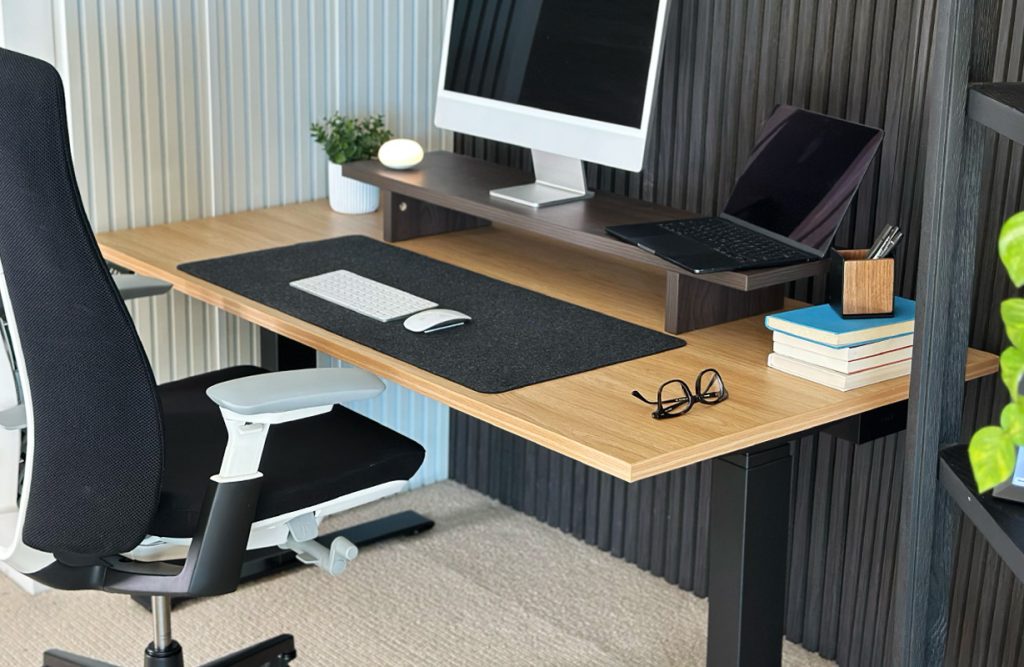
Above: Paired with a Haworth Fern office chair, the Pulse creates a professional-looking workstation.
Cons.
There are quirks.
The hidden power design limits how far the legs can compress, leaving the Pulse with a tall 69 cm minimum height.
Shorter users may struggle to get comfortable.
It’s also one of the pricier desks in this review, thanks to all the built-in cable-management tech.
You’ll pay about a $300-$350 premium for a Pulse when compared with a similar-specced desk from UpDown, Desky or Stand Desk.
And unlike UpDown or Stand Desk, Stando doesn’t offer a 100-day trial, which may make some of you nervous.
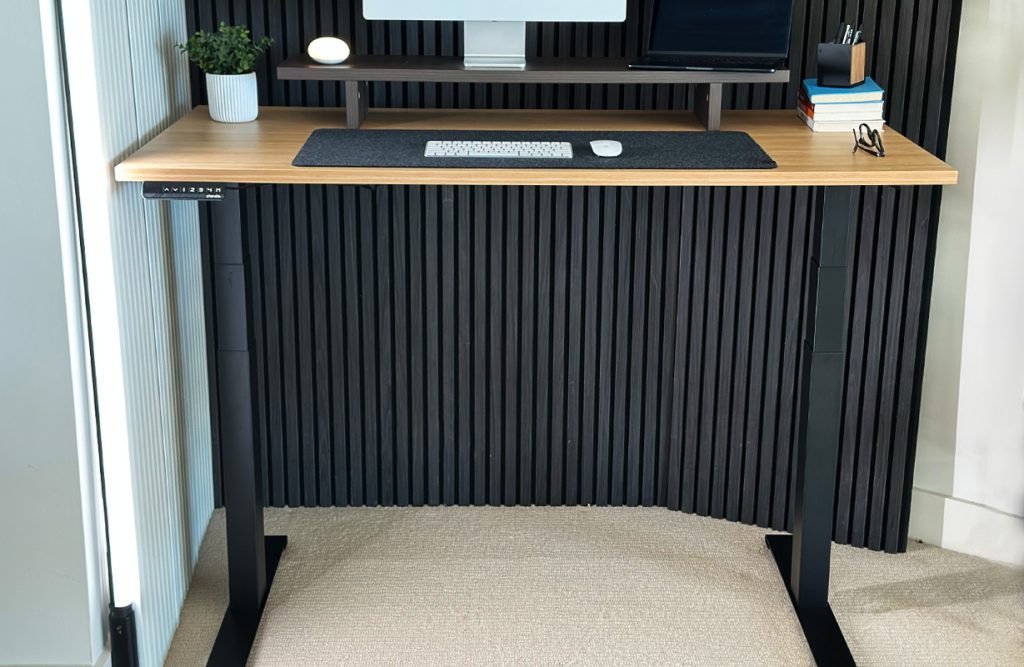
Above: The Stando Pulse looks smart and tidy when extended to full height.
Overall.
| How Does The Stando Pulse Sit-Stand Desk Stack Up? | Score |
|---|---|
| Price | 4/5 |
| Build Quality | 5/5 |
| Aesthetics | 5/5 |
| Cable Management | 4.5/5 |
| Ease of Assembly | 5/5 |
| Extra Features | 4/5 |
| Warranties & Returns | 5/5 |
| OVERALL | 4.4/5 |
The Stando Pulse is a desk for you if you appreciate clever engineering and care deeply about keeping your setup clean.
Forget about it if you’re looking for a bargain.
But if you value time, hate cable clutter and want something that’s both premium and practical, the Stando Pulse is a great choice.
Just check that you’re taller than 175 cm 🙂
6. Secretlab Magnus Pro.
Great standing desk for young men.

Above: Secretlab’s marketing is slick, and the desk’s features are abundant.
The Magnus Pro makes a statement. Sleek marketing and edgy design make it popular with young men and gamers – Secretlab’s core audience.
Honestly, the design alone tempts me to sell my businesses and become a professional Counter-Strike player.
This review isn’t aimed at gamers or uni students – so I bumped the Magnus Pro down the list.
(Related: Secretlab Magnus Pro Full Review: The Good, Bad & Ugly).
Still, no serious roundup of Australia’s best sit-stand desks would be complete without it.
Secretlab set such a high bar for design that I’m a bit obsessed with this desk. I hope other manufacturers stand up (ha) and take notice.
Reasons To Buy & Avoid The Secretlab Magnus Pro.
- Personality. Personality. Personality.
- Out-of-this-world cable management system.
- Great stability.
- Best-in-class assembly experience.
- 5 year warranty is shorter than I expected.
- The metal desktop is heavy (25.5kg).
- Doesn’t escape the gamer/young man vibe.
- No money-back guarantee or trial.
Who Should Buy The Secretlab Magnus Pro.
- Young guys in their 20s who want to build a drool-worthy setup.
- Gamers.
- Creatives.
- Mature people who need to project a sophisticated image.
Specifications.
- aLoad Capacity: 120kg (including 25.5 kg desktop)
- Desktop Sizes: 150X70cm, 177x80cm
- Extension Height: 65-125cm
- Warranty: 5 years on all parts
- Risk-Free Trial: No.
Today’s Best Deals.
b➤ Sale Now On: Visit Secretlab Magnus Home.
Pros.
Like the Stando Pulse above, the Magnus Pro’s #1 party trick is its integrated power delivery system.
Australian standing desk brands – are you paying attention?
This design keeps the desk’s look clean by removing the need for a cable spine or (worse) hiding the cable behind the leg using cable clips.
The cable management p*rn continues upstairs.

Above: The power supply plugs into the base of the leg, removing the need for unsightly cables.
Behind the desktop is a hinged cover that conceals a voluminous cable tray.
It sits flush with the desktop and looks like an integral part of the desk – rather than an afterthought.
Important!
While Desky, UpDown and the like insist that you crawl under the desk to unplug peripherals, the Magnus Pro offers convenient access from the top.
But Magnus Pro’s best feature is its design. I’ll go out on a limb and say that it’s the only standing desk in this review with real personality.
While the personality may not be to your taste, it’s unmistakably there.
You’ll either love it – or hate it.
- Death Star control panel?
- Designer’s dream workstation?
- Gamer’s ultimate console?
You decide. It could be any one of them.
Metal desktop plays a key role here.
Without the (included) MagPad, it looks industrial. Raw. Like something you’d find at a converted warehouse in Alexandria, full of creative hipster types.
You get a choice of colours, with black being the safest, stealth a tad more edgy and the rest decidedly “gamer”.
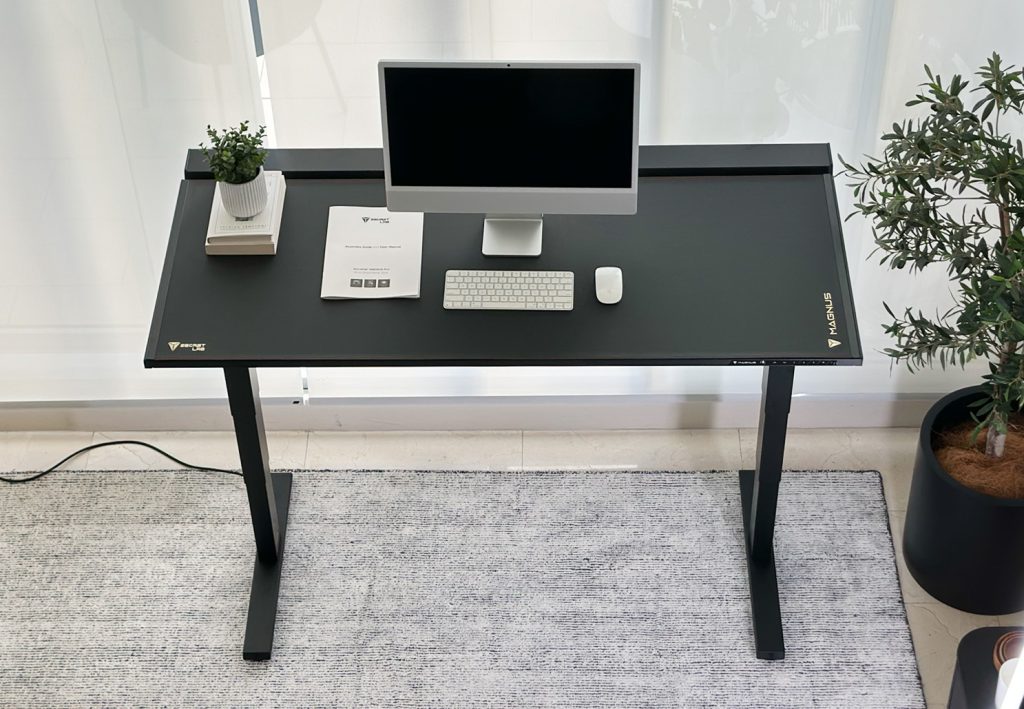
Above: The magnetic pad is on full display here. It runs edge-to-edge, and gives the standing desk a dose of personality. Bored with the look? You can change it for $119.
The desk’s height controller is also decidedly modern. Fully integrated, it sits flush with the front edge of the desk – instead of hanging below.
It’s a minor detail, but I love it. There’s something about the act of switching the desk on every morning that makes it feel more like a part of my team, rather than a lifeless appliance.
It feels alive.
The desk is as stable as all premium desks in this review. Minimal side-to-side wobble once you raise it above waist level. Almost zero back-to-front wobble.
Desktop dimensions are also on point. Your best choice is the 150 x 70 cm size.
Slightly shorter than the standard 150 x 75 cm offered by competitors, it demonstrates Secretlab’s deep knowledge of its target market.
Expert Tip.
Young guys typically live in small apartments or spare bedrooms of their parents’ homes, where a deeper desk would be overwhelming.
Cons.
The Darth Vader-esque aesthetic will turn off many people. Even though the desk isn’t garish by any stretch of imagination, it’s definitely loud.
Bold.
If you want understated minimalism or quiet luxury, you’re better off with the Steelcase Migration SE.
I haven’t seen it in the flesh, but it looks OK in the company’s promo photos – and may be a great compromise if you love the desk, but want to tone down the “black hole” aesthetic.
But then again, isn’t the aesthetic the very reason for its appeal? To me, softening the Magnus Pro’s look is akin to installing a 4-cylinder engine in a Ford Mustang.
There are plenty of polite-looking standing desks on the Australian market.
And who dreams of driving a castrated Mustang?
Important!
If you want a wooden desktop, you can’t have one. Metal only. Sorry, not sorry, boomer.

Above: The height controller sits flush with the desk’s front edge, and has 3 height presets.
The 5-year warranty is also dubious.
I’d expect a sit-stand desk selling for $1200 to offer at least 7 – and preferably 10 – years of coverage.
Scanning the company’s TrustPilot reviews, I didn’t see any complaints about failed electronics.
That said, for young guys, $1200 is a helluva lot of money, and I’d feel less nervous recommending the Magnus Pro if I knew that their hard-earned investment was better protected.
Verdict.
| How Does The Secretlab Magnus Pro Stack Up? | Score |
|---|---|
| Price | 5/5 |
| Build Quality | 4/5 |
| Aesthetics | 4/5 |
| Cable Management | 5/5 |
| Ease of Assembly | 5/5 |
| Extra Features | 4/5 |
| Warranties & Returns | 3.5/5 |
| OVERALL | 4.2/5 |
The Secretlab Magnus Pro is a masterclass in industrial design. It’s also not just a standing desk – it’s an experience.
Does it live up to the hype? Hell yes.
Is it for everyone? Hell no.
In a marketplace saturated with me-too standing desk designs, Secretlab plucked up the courage to build a truly unique desk. And it won.
How do I know?
The young man in me irrationally wants one. Even though I don’t need it.
7. Stilford Lectern.
Great if you live in a tiny apartment (or if you want to keep your fixed-height desk).
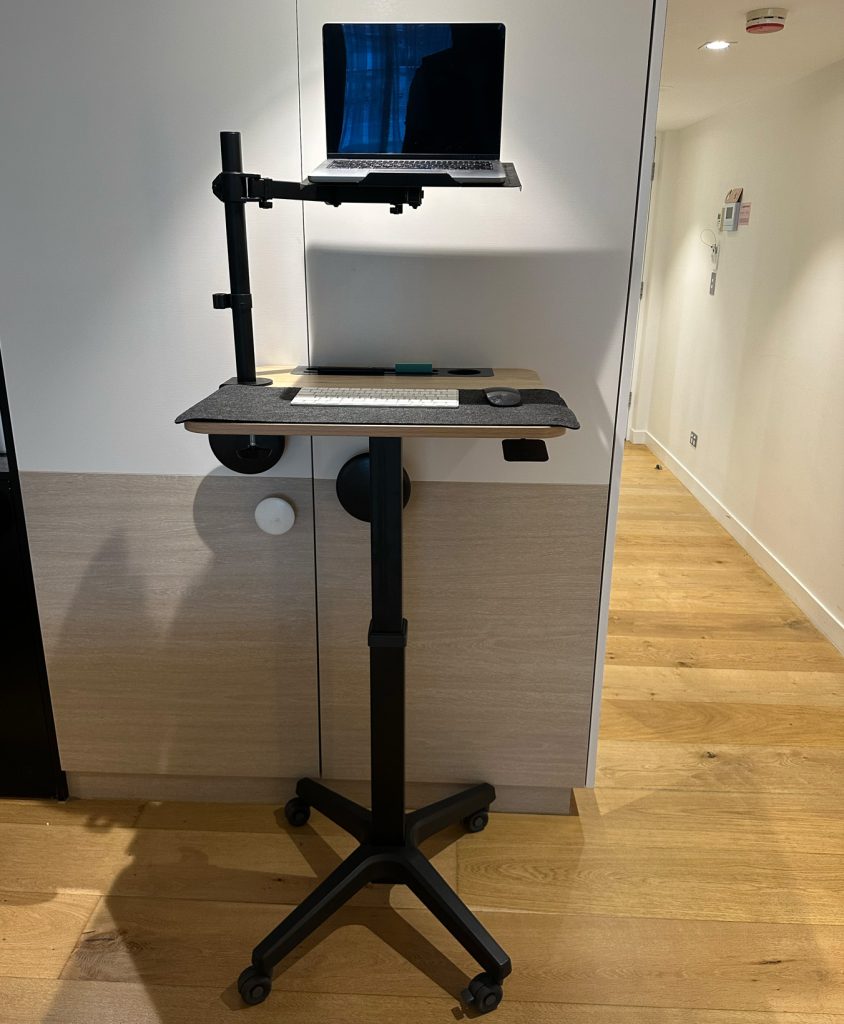
Above: You can roll the Stilford Lectern anywhere you want.
I encountered this puppy while casually browsing the standing desks section of my local Officeworks on a Saturday morning.
Initially expecting to dismiss it as cheap rubbish, I quickly realised how wrong I was.
This is a very impressive little standing desk. So much so that I ended up buying one.
Reasons To Buy & Avoid The Stilford Lectern.
- Very budget-friendly.
- Doesn’t wobble much considering its single-pole design.
- No electrical components means it will last a lifetime.
- Sold and backed by Officeworks.
- You can keep your existing fixed-heigh desk.
- Great for tiny spaces.
- Easily wheel it anywhere you want. Work from your balcony, alfresco, living room or home office.
- Small desktop size means you can’t use it with large monitors or desktop computers.
- You’ll need to buy a laptop arm and external input devices to improve ergonomics.
- You can buy an Artiss – a “real” standing desk – for about the same price.
Who Should Buy The Stilford?
- People who don’t want to throw out or sell their existing fixed-height desk.
- Workers who want to spend most of their workday sitting, with short periods of standing in between.
- Small business owners who want to give their empoyess the option to work standing without having to reconfigure the office.
- People who want the flexibility to work from anywhere in their home.
- People who live in tiny apartments.
- Workers who want a full-size, “real” height-adjustable standing desk.
- Workers who don’t have a laptop.
Specifications.
- Load Capacity: 40kg
- Desktop Sizes: 60x50cm
- Extension Height: 75-115cm
- Warranty: 15 years
- Risk-Free Trial: No, but Officeworks will accept a return if you change your mind within 30 days, provided the desk is in sellable condition and includes original packaging.
Today’s Best Deals.
➤ Stilford: Check Officeworks.
Pros.
Hold on, Steven. This is not a real standing desk, I hear you say.
And you’re right.
But not everyone needs a full-size, electrically adjustable, permanently fixed, 75kg monstrosity that costs $1,500.
Important!
The Stilford Lectern will appeal to people who want to retain their existing (i.e., non-height-adjustable) desk, but also want to stand for a few hours daily.
You can roll it around, which gives you the flexibility to work from your living room one day and from your balcony the next.
Its tiny footprint means you can stash it away in an unused part of your home when you’re done with it.
Despite its single-pole design, it’s more sturdy than many standing desks I’ve had the (mis)fortune to use.

Above: A handy tray for your stationery is at the rear of the desktop.
It’s not as wobble-free as the Artiss or any of the premium desks above, but even at full extension, the wobbles are acceptable.
All parts feel good to the touch.
The frame is made from solid metal. And yes, the desktop is made from particleboard.
The quality of the desktop is very similar to that of Artiss. It’s typical mass-produced office value fare – not special, but not offensive.
Expert Tip.
Officeworks will deliver the Stilford Lectern to most metro areas for $49.95.
The height adjustment is very simple and fully manual, via a little lever at the bottom of the desktop.
The back of the desktop houses a handy tray for storing small booklets, pens and your morning brew.
Cons.
Yes, the Stilford lectern is cheap, but some will say that at $306, it’s overpriced. For context, an Ikea Trotten (below) is $299, while the Artiss (above) starts at $290!
Both of those are “real” standing desks, with larger desktops and two legs.
That is a valid point, but your decision will depend on your needs. If you need:
- The cheapest possible traditional standing desk, buy the Artiss.
- To supplement your existing sitting desk with a smart-looking, movable standing table, get the Stilford.
Stilford’s biggest downside is ergonomics.

Above: The Vivo laptop arm raises the screen to eye level, freeing up space on the desktop.
Your laptop’s screen will always be at the same level as your keyboard, which means you’ll always be looking down at your screen while standing.
I fixed this issue by buying a $69 Vivo laptop arm from Amazon. However, this bumped the total price up to $375. You’ll also need an external keyboard and mouse. If you don’t already own those, budget another $150-$250.
Only you can decide.
The rest of Stilford’s downsides are, predictably, the opposites of its strengths.
The workspace is not large. It is enough for a laptop, an external keyboard and mouse, a small notepad, a phone, and a few pens, but not much more.
Expert Tip.
Raising the laptop using the Vivo laptop arm frees up a lot of space.
Speaking of laptops, they’re the best use case for this desk. Despite its sturdiness, I wouldn’t place a computer monitor or desktop computer on it.

Above: Placing your laptop directly on the desktop eats up most of the available space. Nonetheless, the desktop is large enough to be useful.
You’ll start rolling it, forget to unplug the cable and watch your expensive electrical equipment tumble to the ground.
Stilford would agree with my recommendation, so it doesn’t offer cable management accessories with the lectern. But you can definitely park it next to a wall power plug to charge your laptop.
Verdict.
| How Does Stilford Lectern Stack Up? | Score |
|---|---|
| Price | 5/5 |
| Build Quality | 4/5 |
| Aesthetics | 3/5 |
| Cable Management | 0/5 |
| Ease of Assembly | 5/5 |
| Extra Features | 2/5 |
| Warranties & Returns | 4/5 |
| OVERALL | 3.3/5 |
Inexpensive and versatile, the Stilford is the oddball standing desk in this review.
In the ocean of same-same products, it offers you the flexibility that no other standing desk can.
8. Steelcase Migration SE Pro.
The most stylish (but expensive) standing desk.
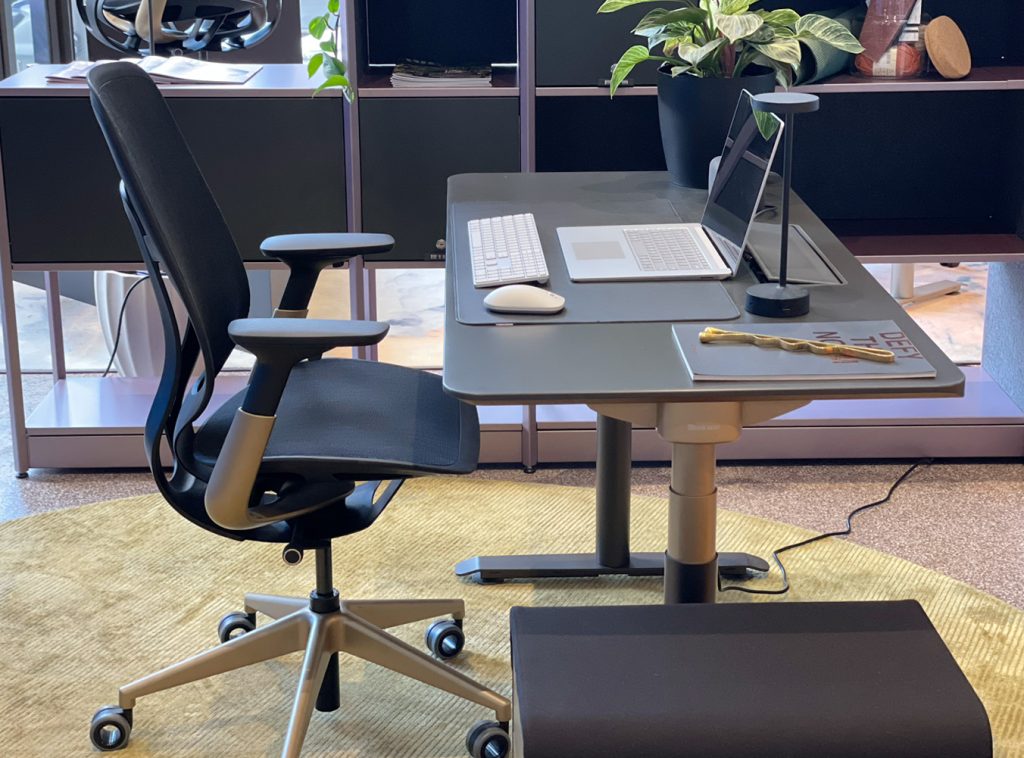
Above: I viewed and photographed the Migration SE Pro in Steelcase’s Sydney retail shop.
Reasons To Buy & Avoid The Steelcase Migration SE.
- Stylish, upmarket aesthetic makes you feel like you’re getting a lot of desk for your money.
- Solid internals (dual motors, solid frame, 4-button programmable controller).
- 12 years of warranty on electronics, lifetime on the frame.
- Price will be an issue for most people.
- The 1400x750mm max destop size and 650mm minumum height will be limiting to some users.
- Flip top cable manageemt flap looks unfinished.
Who Should Buy The Steelcase Migration SE Standing Desk?
- People who hire interior designers, or are interior designers
- People who wear thick-rimmed glasses, are “in the arts”, and find notes of “asparagus” in their Merlot.
- Price-sensitive people.
- Photographers, videographers, traders and gamers who run ultra-wide screens, or multiple screens.
Specifications.
- Load Capacity: 125 kg
- Desktop Sizes: 120x70cm, 140x70cm
- Extension Height: 65-125cm
- Warranty: 12 years on electronics, lifetime on frame.
- Risk-Free Trial: None.
Today’s Best Deals.
➤ Steelcase Migration SE Pro: Check Steelcase Website.
The sad reality is that while most standing desks appear reasonably stylish, none are particularly beautiful.
Migration SE Pro addresses this issue with a sophisticated, clean, and minimalist design. Think of it as a stylish office desk that also happens to be adjustable.
(Related: Steelcase Migration Pro SE Full Review: The Good, Bad & Ugly).
It’s a desk for people who appreciate a great aesthetic – and are not sensitive to price.
At nearly $2,000 (plus shipping), the Migration SE Pro is expensive.
Steelcase is a premium brand, and the desk’s design language signals exclusivity.
In this context, the high sticker price is not a downside – it’s part of the appeal.
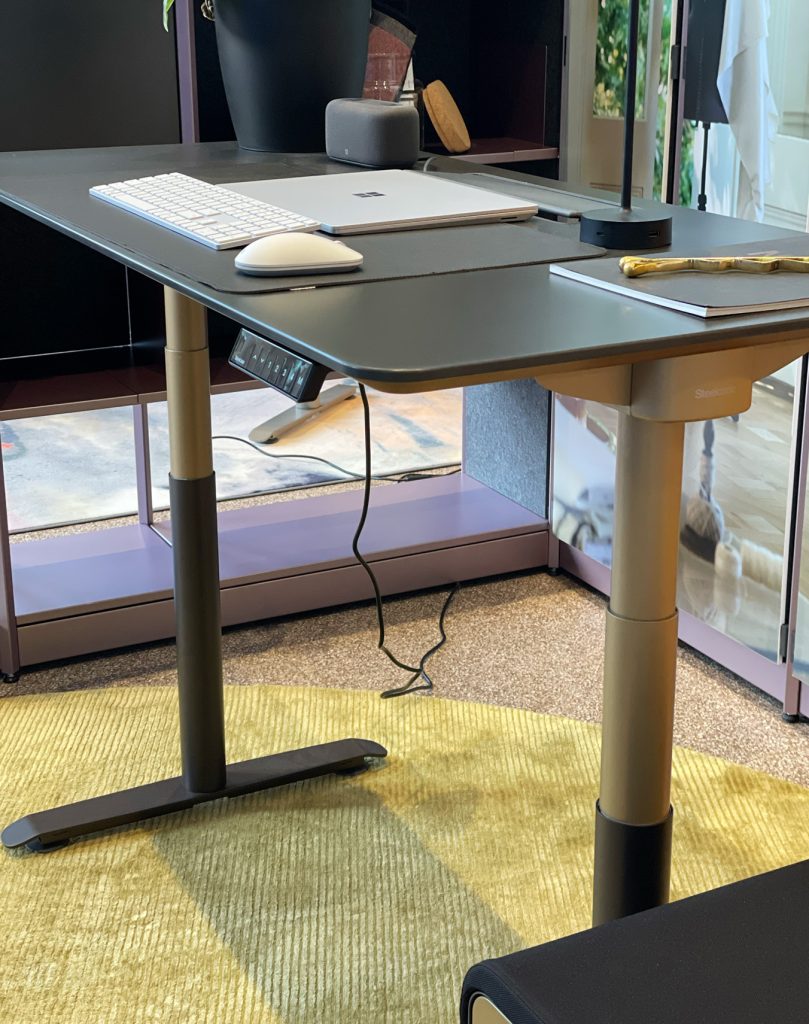
Above: The traditional T-leg design, featuring two-tone round column segments, creates a sleek, futuristic look.
The good news is that Migration SE’s build quality aligns with the price.
Commercial-grade pressure laminate desktop with a contrast-coloured chamfered front edge looks striking and feels nice to the touch.
The frame is stable front-to-back and side-to-side, with a 125kg lifting capacity and a speedy 38mm/sec adjustment speed.
Expert Tip.
Tubular legs are usually a red flag for me due to their notoriously poor glide fit, but I’m happy to report that they’re not an issue here.
Unfortunately, shorter users may find the 65 cm minimum height limiting. If that’s you, a Desky, with its 60 cm lowest height setting, may be the best option.
I love the “Flip Top” cable management feature at the rear of the desk, which allows you to run cables directly to the cable management tray without having to rummage under your desk.
Magnus Pro is the only other standing desk in this review that offers this feature (but Magnus’ tray is much wider and more usable).
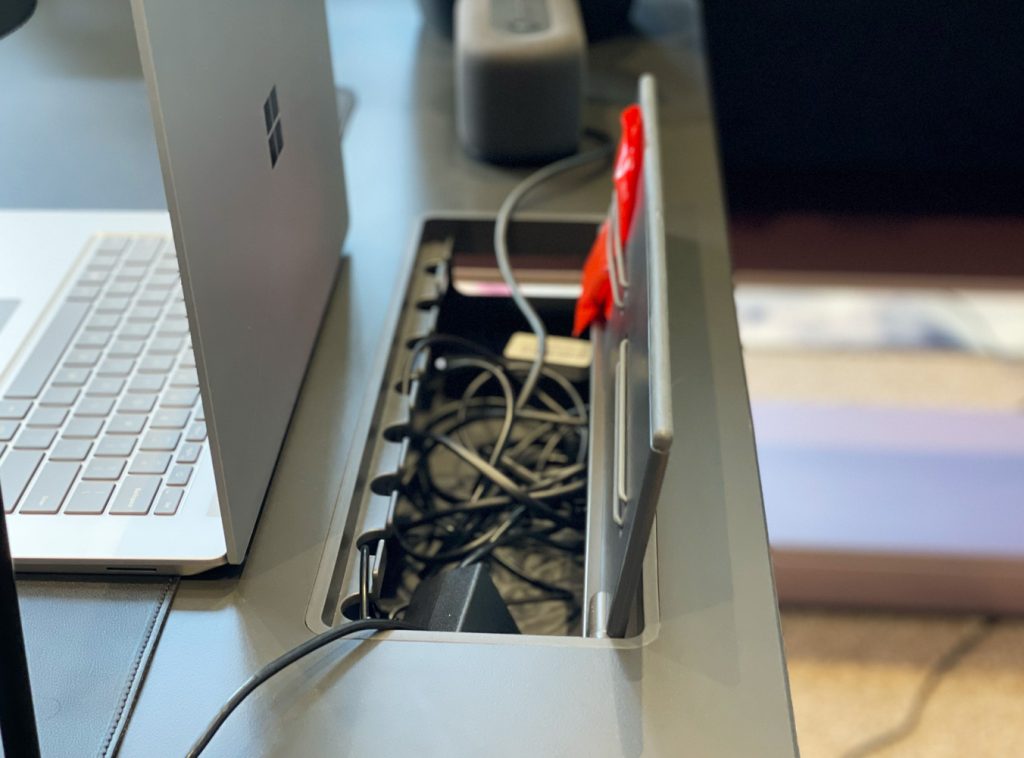
Above: The “Flip Top” cable management lid at the rear of the desk works very well, but looks untidy when closed.
However, I wish the Steelcase designers had created cutouts in the lid for cables. These would allow the lid to close fully.
The partially open lid detracts from the clean lines of the Migration Pro.
Important!
Two desktop sizes are available, and both are comparatively compact. The 120×70 cm desk is a compact option that will appeal to those with limited space. Meanwhile, the larger 140×70 cm option offers about 20% less desktop space than the “industry standard” 150×75 cm size offered by most competitors.
Nonetheless, it will easily accommodate most users, except those who run two large monitors side-by-side.
Is this the right standing desk for you? Well, it depends on your priorities. If you:
- Want a practical, high-quality standing desk, UpDown, Desky and Stand Desk are better options.
- Have an eye for design and/or want a feature piece in your home office, the Migration SE Pro is worth every dollar.
Last but not least, Steelcase’s warranty is the best of all desks in this review. You get total peace of mind with 12 years of coverage on electronics and a lifetime warranty on the frame.
Overall.
| How Does Steelcase Migration SE Pro Sit-Stand Desk Stack Up? | Score |
|---|---|
| Price | 3/5 |
| Build Quality | 4.5/5 |
| Aesthetics | 5/5 |
| Cable Management | 4.5/5 |
| Ease of Assembly | 4/5 |
| Extra Features | 4/5 |
| Warranties & Returns | 5/5 |
| OVERALL | 4.3/5 |
9. Recess, Flexispot E7-Pro, Omnidesk Ascent.
Decent standing desks (with issues you must be aware of).
These brands sell premium standing desks that I chose to disqualify from the leading pack – for a number of reasons that I’ll discuss below.
Recess.
The 100% Aussie company sells standing desks at the ~$1,000 price point.
Their key differentiator is the fun range of colour choices. These include green and blue legs as well as green and black desktops.
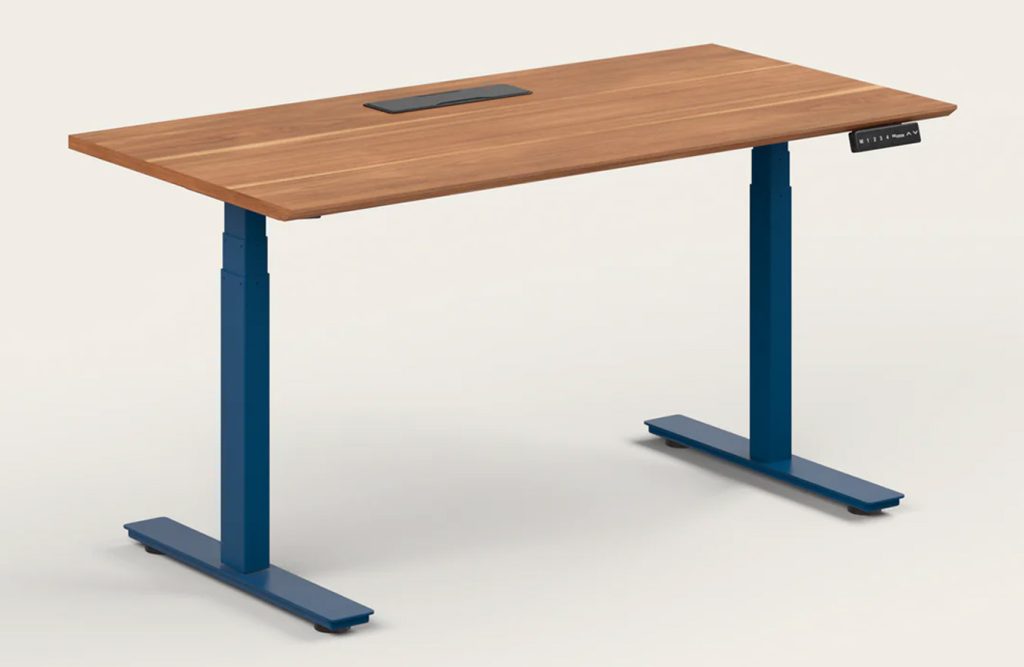
Above: Recess standing desk speced with blue legs and walnut desktop. The colour contrast is nice – if you’re going for that early-stage startup look.
The company has a Sydney showroom, where you can touch, feel and smell your sit-stand desk before buying.
Despite premium-level pricing, it offers the most oddball warranty of all desks in this review.
The lifetime warranty on the desktop and frame is best-in-class. But the two-year coverage on electrical components is among the shortest.
Only the $300 Artiss offers a shorter warranty..
This worries me when spending about $1,000 on a standing desk, as electronics are parts most likely to fail.
Important!
Recess’ premium competitors, such as UpDown, Desky, SecretLab and StandDesk, cover electronics for between 5 and 10 years.
Flexispot E-7 Pro.
Flexispot is a US-based company that sells a range of standing desks, from budget-minded wobbly nightmares to the flagship E-7 Pro.
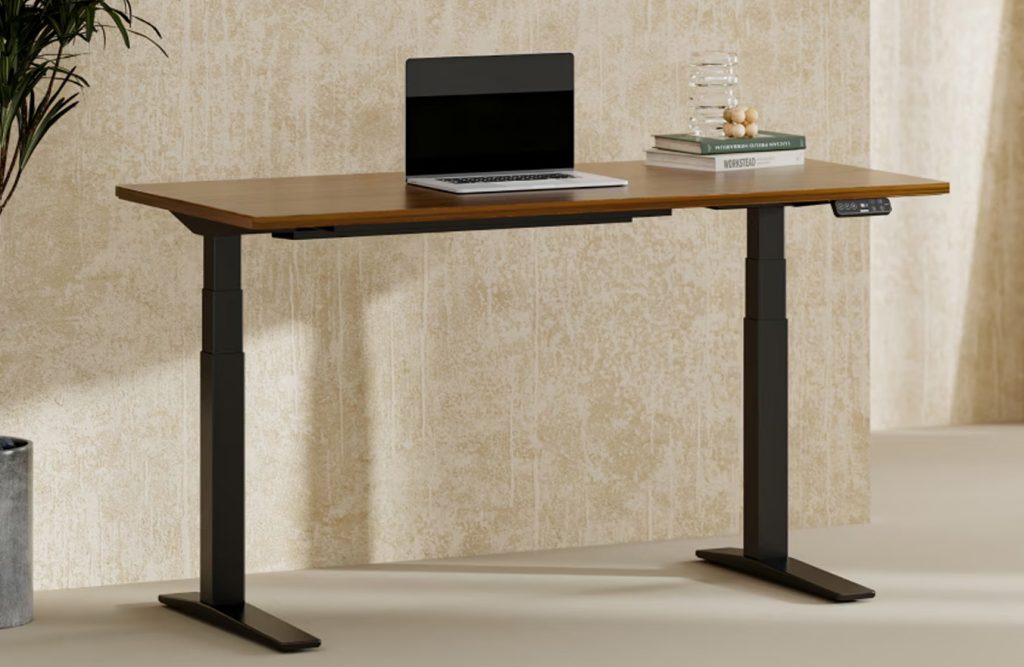
The E-7 looks promising, but my #1 concern with Flexispot is support.
I suspect the company drop-ships the desks directly from a US warehouse.
If something goes wrong during the delivery (or after), would you rather be dealing with a medium-sized, direct-to-consumer Australian company in your timezone or a huge business-to-business retailer in the US?
Omnidesk Ascent.
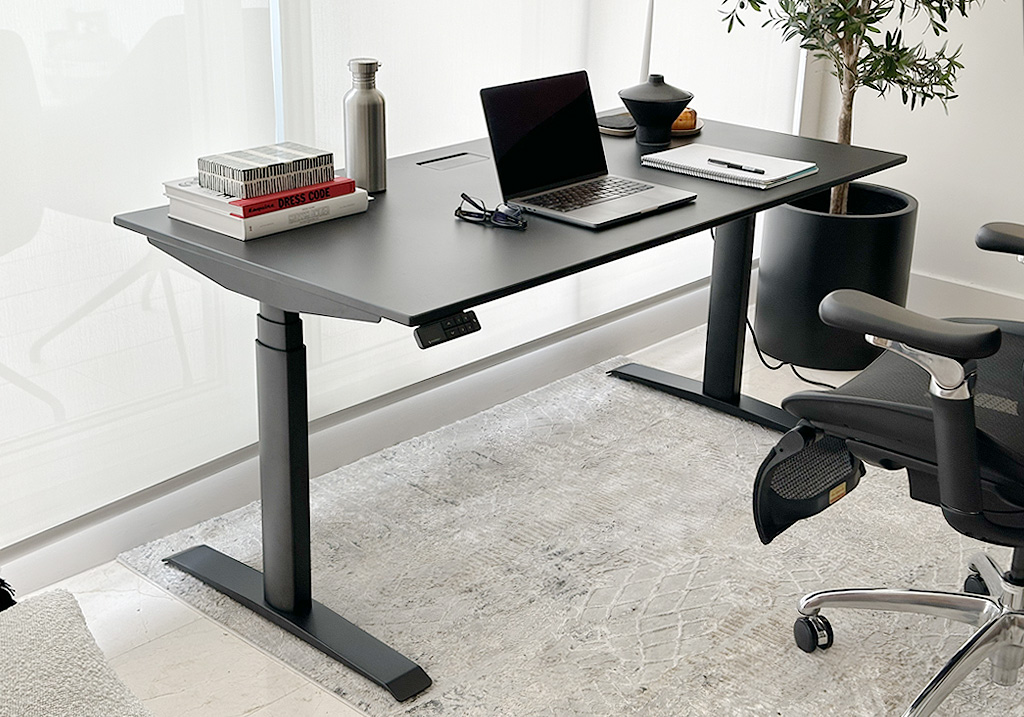
On 19th November, I decided to move the Omnidesk into the last position.
It was a difficult decision, because I love the desk – and it tied with Desky and Stand Desk in the #2 spot for all of 2025.
But the company has been experiencing stock issues since September.
I contacted the company for clarification. They assured me that business is operating as usual, and stock issues will be resolved by October.
However, as of the time of this writing, we’re well and truly into November – and the situation is the same.
I don’t want to speculate what may be happening behind the scenes. But the more time passes, the less this looks like a simple supply chain glitch.
And I’m not comfortable recommending Omnidesk until the company fixes this issue.
3 Standing Desks You Must Avoid.
Not all standing desks are created equal. These models are very popular – but not for the right reasons.
Ikea Standing Desks: Trotten, Bekant & Idasen.
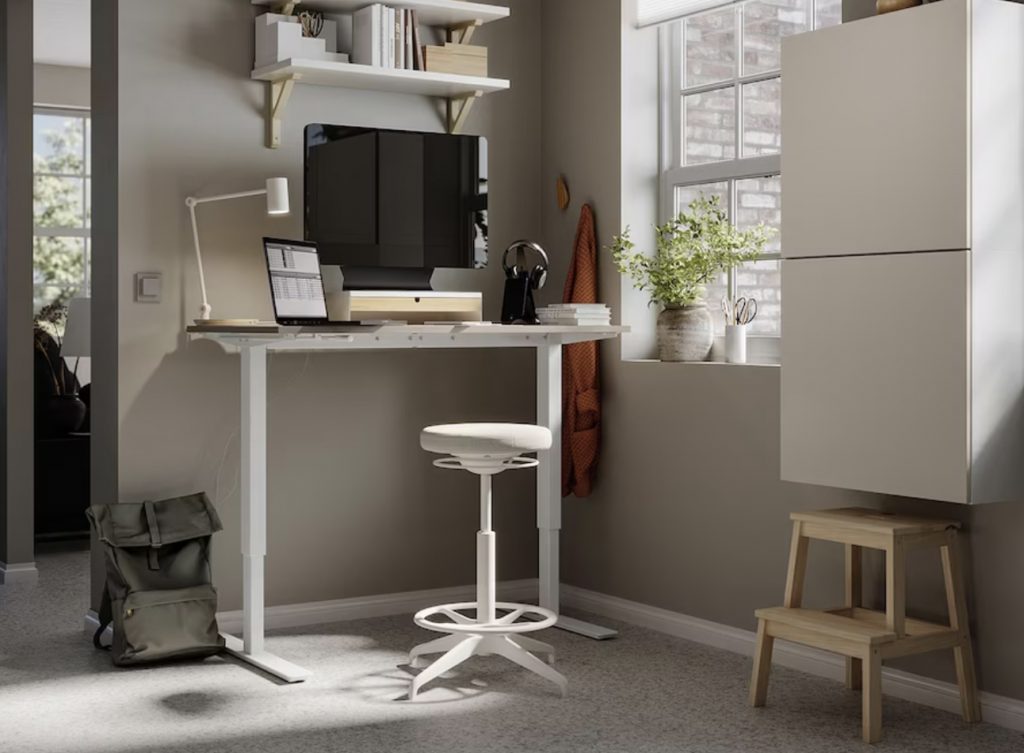
Above: The Ikea Trotten looks quite smart from a distance. You notice the budget construction when you get close and interact with it.
The Ikea Trotten is a manual standing desk for people on a tight budget. I inspected it closely the last time I visited Ikea and walked away feeling more impressed than I thought I’d be.
- I expected it to feel cheap, wobbly and flimsy, but it wasn’t.
Of course, it was nowhere near as sturdy as the premium options from UpDown and Desky, but at 20-40% of their price (depending on your choice of desktop), it’s not a fair comparison.
Well, yes.
Because the Artiss is $290-$390 – and it’s much better. And it will get delivered to your door.
The Trotten will appeal to university students and early-stage startup founders who have been kicked out of all local cafes for overstaying their welcome.
Expert Tip.
Laptop warriors won’t find this a problem, but if you have a couple of monitors and a desktop PC, you may find yourself nudging against it rather quickly. Don’t forget that your arms rest on your desk – and count towards the weight limit.
Bekant sit-stand desk is Ikea’s cheap-ish option. I excluded it from this lineup because of its telescopic round legs (notorious for being wobbly) and so-so desktop finish.
While its desktop is much better than Bekant’s the telescopic legs are a deal-breaker.
It retails for about $950; for this price, you’re almost in UpDown and Desky territory.
Pros.
- Prices range from very cheap to reasonably cheap.
- Great returns policy.
- Ikea reputation.
Cons.
- Looks and feels cheap – because it is.
- Um. Ikea reputation.
Is Melamine Better Than Wood Veneer?
The biggest difference between melamine and wood veneer is that the former is made from plastic, while the latter is made from real wood. Both are bonded to a particleboard during manufacture to create the outermost layer of the desktop. Melamine is cheaper and more durable, so it’s more popular in commercial offices.
My Criteria For Choosing The Best Standing Desk.
The 7 categories I used to evaluate each standing desk are below.
| Build quality | Does the desk wobble? How much metal is in the frame? How thick are the crossmembers? Does the controller feel cheap? Does it have subtle ‘nice-to-have’ details (e.g., rubber grommets between metal parts) |
| Aesthetics | How many desktop wood choices are available? Do entry-level wood choices feel cheap? What does the controller look like? |
| Warranties & returns | What do you get, above and beyond the standard Australian consumer protections? Can you get a full refund if you don’t like the desk? |
| Ease of assembly | How clear are the assembly instructions? How many boxes does the desk arrive in? Do the parts fit logically? |
| Cable management | Is the cable tray included? How useful is it? Does the desk have grommets, cable channels or scallops? |
| Extra features | Does the desk have any unexpected “nice to have” features? (For example, wireless charging pads, built-in cable management slots). |
| Price | How much value does the standing desk offer in the context of its price segment? |
The 3 Types of Standing Desks – Explained.
You’ve probably realised that “standing desk” can refer to one of 3 product types.
Terms like “standing desk”, “adjustable sit-stand desk”, “standing table” and “stand-up desk” are often used interchangeably when referring to all of these product types.

1. Sit-Stand Desk Converters.
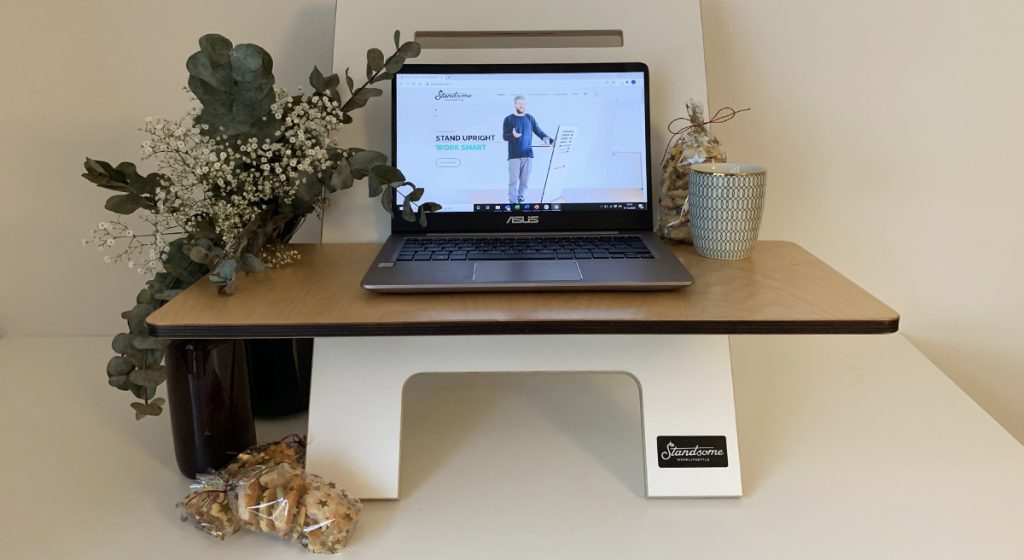
Above: A very basic standing desk converter. You can pick one of these up for less than $250.
A converter is a device you place on top of your existing desktop. It moves up and down, elevating your workspace.
People choose converters because they’re much cheaper than floor-standing electric standing desks.
They’re also more practical, as you can keep your existing desk (and put away the converter if you don’t use it).
But they’re a suboptimal option because of their poor lifting capacity.
Important!
They also raise your existing desktop by about 3cm. If you’re tall, you’ll probably need to buy a taller office chair (or buy an extra-long gas piston for your existing chair).
2. Adjustable Height Standing Desks.
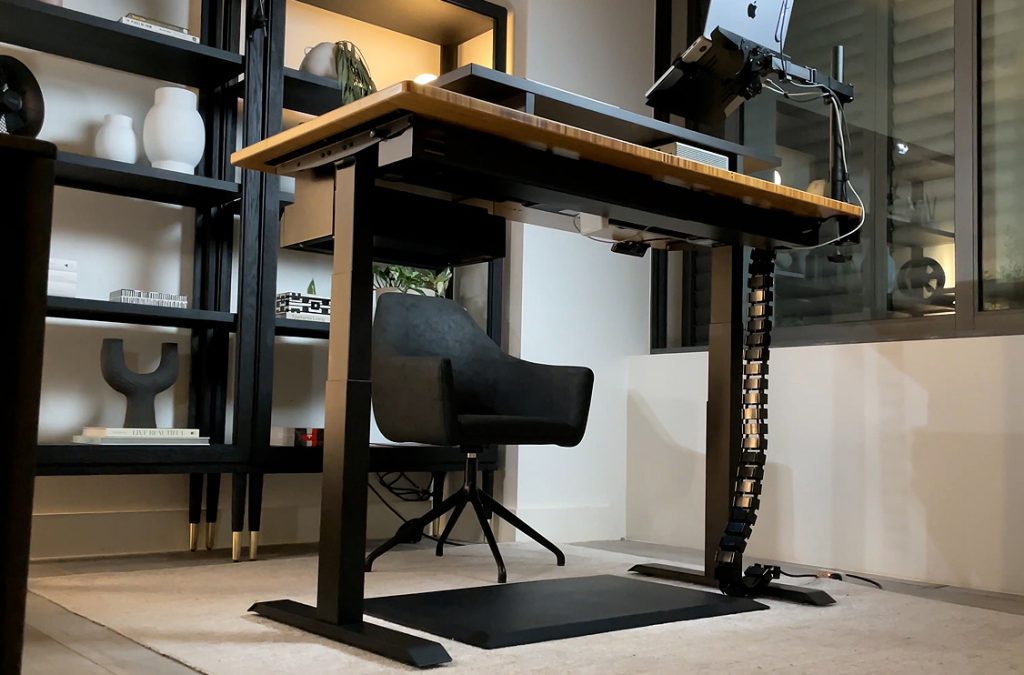
Above: The Desky dual at nearly full extension. Easily one of the best standing desks in Australia.
Floor-standing adjustable desks offer unbeatable ergonomics. I focused exclusively on them in this review.
You get two desks in one device – a standing desk and a traditional sitting desk.
They are available in three types:
- Manually Adjustable. You change the desk’s height by operating a hand crank. These desks have low lifting capacity (between 50 kg and 100 kg) but are cheaper than electrically adjustable desks.
- Electrically Adjustable. You raise and lower the desk by pushing a button, and letting the motors do the rest. Single-motor models have lower lifting capacities (between 60 kg and 80 kg), while dual-motor models can lift as much as 150 kg.
- Pneumatically Adjustable. Relatively rare in Australia, these use a pressure coil assembly to push the desktop up. I don’t recommend them, as they’re simultaneously complex and expensive.
Expert Tip.
The main downside of an adjustable height floor-standing desk is that it will make your current desk obsolete. You’ll need to sell it or give it away.
3. Fixed-Height Standing Desks.
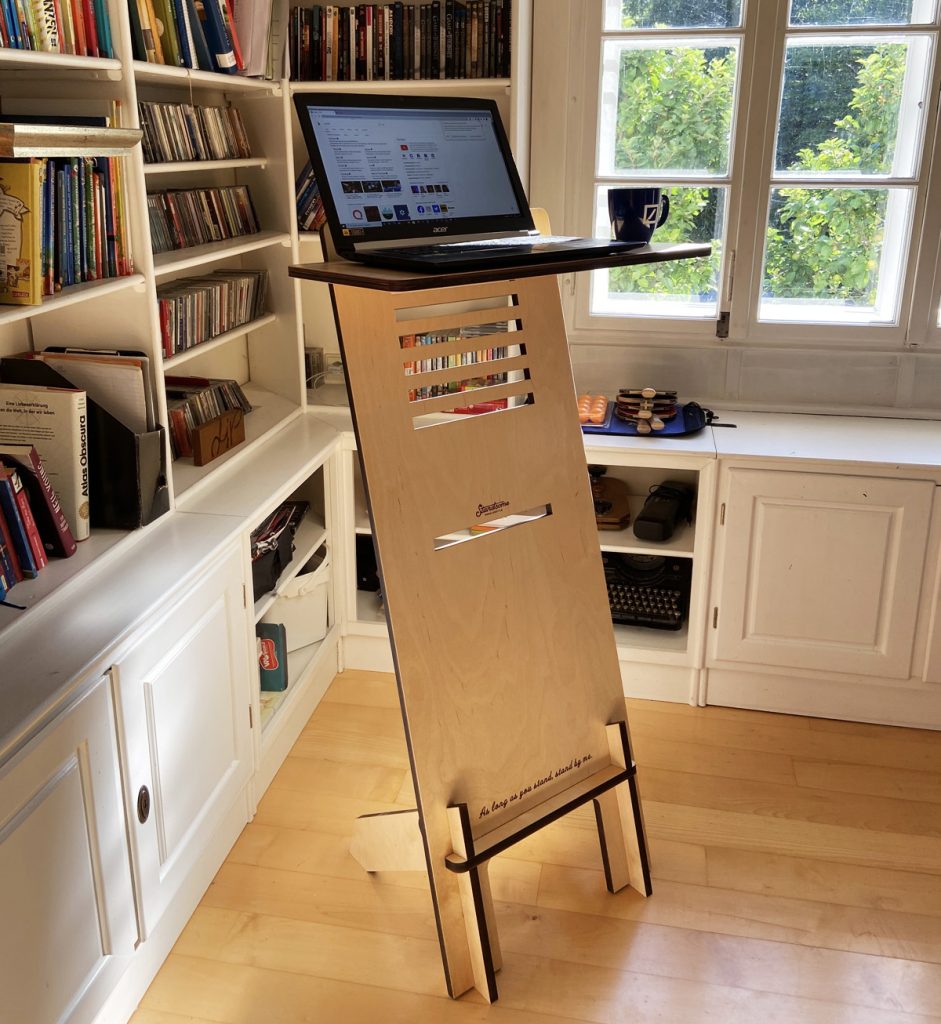
Above: This unusual-looking contraption isn’t height-adjustable. You’ll be staring down at your laptop all day.
Fixed-height standing desks are typically made from wood, and feature much smaller desktops.
Ergonomics is all about adjustment. Why confine yourself to a fixed standing height when you have one that adjusts perfectly to your needs?
Frequently Asked Questions About Standing Desks.
I receive a lot of emails from people who are about to purchase their first stand-up desk. Below are my answers to the most common queries.
1. Manual vs Electric Standing Desks: Which Are Best?
Some people prefer manual standing desks due to their perceived reliability. The fewer electronics, the fewer chances of something going wrong, right?
Manual lifting mechanisms are not immune to failure, while modern electronics are extremely reliable and cheap.
You are not likely to experience issues with the lifting motors of your electric standing desk – especially if you buy one of the best-rated options in my review.
Expert Tip.
Only buy a manual standing desk if your office doesn’t have a reliable power supply.
2. How Important Is Stability?
Very.
Working on a standing desk that wobbles is very annoying.
Contrary to popular opinion, placing more equipment on the desktop (e.g., large monitors) does not solve the issue. It has precisely the opposite effect, as it raises the desk’s centre of gravity.
At the low to mid-range, most standing desks are very stable. Even the cheap ones.
Important!
But price alone is not the best predictor of stability. I’ve tested plenty of desks that cost more than $1,000 and wobble horrendously.
Side-to-side instability is particularly difficult to eliminate, but it’s also not as important, as you’re unlikely to introduce lateral motion to your workspace.
Front-to-back stability is your priority.
It will largely depend on the build quality of the columns. The less play between the columns, and the more overlap between each section, the more sturdy the desk will be.
3. How Slow Is Too Slow?
Most standing desks on the Australian market are fast enough. Anything above 30mm/sec is fine.
Budget brands (e.g., Artiss) are likely to lift at a more modest speed (about 25mm/sec). It’s a little frustrating, but not infuriating.
Some manufacturers offer speeds as high as 50mm/sec (Stand Desk) and 43mm/sec (Omnidesk), but they achieve this by sacrificing maximum lifting load.
Important!
Don’t get caught up in these nuances – they’re not important.
4. Should You Buy A Cheap Standing Desk?
I haven’t included any of the ultra-cheap desks in this review. While it’s possible to pick one up on Amazon or at Officeworks for less than $250, this is an exercise in false economy.
Dodgy connection points, thin metal and el-cheapo electronics add up to poor stability and questionable longevity.
I personally wouldn’t place my Apple Studio Display on one of these.
Stepping up to mid and upper-range standing desks has a number of payoffs:
- You get thicker columns, heavier feet and more robust actuators. While desks at this price point are not always rock-solid, none of them feel like they’ll blow over with a gust of wind.
- You also get one-touch adjustment with programmable buttons, as well as well-calibrated collision avoidance sensors. Bluetooth connectivity, timers and built-in chargers are also the norm.
- Gears inside the columns also receive an upgrade. These are hidden from view inside the lifting columns, so manufacturers love to cut costs here. Cheap gears will wear out or break if your desk is overloaded, or runs into your chair (and the anti-collision sensor malfunctions).
- Motor quality is reflected in desk lifting speeds and maximum lifting loads. The higher they are, the more torquey the motors. Stronger motors last longer than cheap ones because they work less hard when lifting the same load.
- Stronger warranties give you more peace of mind. Expect about 7-10 years on frames and electronics from premium brands and as low as 1 year from cheaper ones. Also, warranties are only as strong as the brands that offer them. When something goes wrong, I like knowing exactly which throat I need to choke, and where it’s located 🙂
5. Are Standing Desks Good For Your Health?
Yes and no.
According to Australian musculoskeletal physiotherapist Antony Lo, moving throughout your workday is the most important thing you can do for your health.
Your body is happiest if it adopts various positions throughout the day. Alternate between sitting and standing every 1-2 hours for best results.
That said, standing desks are not a miracle cure that is guaranteed to make your aches disappear.
6. Are Standing Desks Worth It?
Yes. After switching from a regular sit-down desk, I haven’t looked back.
- I start my day sitting. After working for 2-3 hours, I switch to standing mode until lunch.
- After lunch, I tend to stand again for a couple of hours, and finish my day sitting.
This works best for me. What’s your sit/stand schedule? Let me know in the comments below.
By the way, you’ll find studies “proving” that standing desks increase productivity by 45%. I call BS on this one.
Productive people are productive regardless of their surroundings.
When I started my first business, I worked like an animal for 12 hours daily – from a cheap couch and a $50 laptop table.
7. Which Accessories Should I Buy For My Stand-Up Desk?
Don’t get carried away. It’s easy to spend over $2,000 on desk accessories, but in my experience, most of them are useless. Here are the top five upgrades I recommend:
| Accessory | Budget | Why You Need It |
|---|---|---|
| Ergonomic Chair | $350-$2,000 | Chairs with at least 8 points of adjustment and 8 years of warranty are best. |
| Lockable Drawer | $100-$150 | Located under your desktop, it keeps your workspace clutter-free. |
| Cable Management | $100-$200 | Invest in a cable channel, extra power boards, cable ties and a cable spine to keep your workspace tidy and remove tripping hazards. |
| Lockable Storage Cabinet | $200-$300 | For keeping your paperwork, files, extra hardware and spare stationery. |
| Standing Mat | $50 | Non-negotiable. A mat quadruples the length of time you can stand before your feet get sore. |
Expert Tip.
People accessorise their stand-up desks with under-desk treadmills and balance boards, but in my experience, these are fads that are more likely to collect dust than help you get in shape.
8. How long do adjustable desks last?
The majority of adjustable desk manufacturers provide a minimum three-year warranty, while the top ones offer a 10-year warranty on all parts and desktops.
9. Do electric adjustable standing desks consume a lot of electricity?
Contrary to popular belief, electric standing desks consume minimal electricity.
Typically, they use around 150 W when actively in use, solely powering the dual motors and (if present) the wireless phone charger.
10. What size desktop is best for my home office?
Most sit-stand desktops on the Australian market are sold in the following widths:
| 120 cm | Best for small inner-city apartments and terraces (less than 120 square metres). |
| 150 cm | Best for regular-sized Australian homes (250 – 350 square metres). |
| 180 cm | Best for two-person setups, as well as single users with a lot of gear. |
What if I Have A Very Small Home Office?
Keep your desktop’s depth under 60 cm (most desktops range between 60 cm and 80 cm).
11. What’s the difference between static and dynamic rating?
Your forearms aren’t that heavy, and neither are your computer, monitor, coffee mug, and notepad. They are unlikely to weigh more than 25 kg.
Expert Tip.
Standing desk manufacturers tend to set desk lifting limits between 50 kg and 180 kg. While you’re never likely to exceed their limits during a typical workday, the rating is a great proxy indicator of the desk’s overall build quality. A higher rating means motors with more torque, rated for a greater number of cycles.
Here’s what you need to know about static desk lift capacities:
| Static Rating | Refers to the maximum load you can place on a stationary desk. |
| Dynamic Rating | Refers to the maximum load you can place on the desk while it’s either rising or lowering. |
Burnt-out motors are typically the most common cause of electric desk faults. The less wear and tear you place on the motors, the longer they’re likely to last.
Important!
If your desk is rated to 60 kg and you place a 30 kg load on it, it will operate at 50% of its maximum capacity. However, if your desk is rated to 150 kg, the same load will only represent 20% of its maximum capacity.
Why Did I Write This Review?
When I was starting my first business, I worked from my kitchen table for 60 hours a day. This type of scrappiness is vital when starting out, but it’s not sustainable in the long term.
You need to invest in a home office that separates your living and work areas, or you’ll never be able to relax.
Unfortunately, the Internet is full of BS astroturf reviews that sell myths and make false promises to potential standing desk buyers.
For example:
- Sitting is the new smoking (it’s not).
- Standing has a lot of health benefits (this is somewhat true, but the science is flimsy).
- Standing at work helps you burn more calories (it doesn’t).
- Certain standing desks are much better than others (this is only true when comparing very cheap vs very expensive desks. As I’ve shown above, most standing desks at the same price point are more similar than different.
I also discovered that hidden incentives skew the reviews in favour of the publishers and desk retailers. You, the consumer, are left in the dark.
The first type of “best standing desk review” you’ll see online is of the “desk for a favourable review” variety.
Here’s how it works.
A standing desk company sends a desk to a content creator, expecting a glowing review in return.
The content creator (usually a young guy with aspirations of fame and glory) takes the bait. He gets a free desk.
The second type of “best standing desk review” is even worse.
This “expert” is usually middle-aged guy with a soul-sucking 9-5 job he is desperately trying to escape by building a review site.
He has never seen the desk in person and instead regurgitated conclusions from other reviews, likely using ChatGPT.
He wants you to buy the desk so he can finally tell his boss to go f*ck himself and never work again. His financial freedom is just around the corner.
Passive income, baby!
- What neither of these guys realises is that they’re one Google update away from being wiped out.
- What you don’t realise is that their recommendations have nothing to do with your needs.
What makes me different?
My businesses generate over $5m in top-line revenue each year, and I have a team of over 15 people working for me.
While the commissions I receive from this review are nice, I’m not exactly relying on this money to live. Or to escape my job.
I also love geeking out over how things work, so I often write these reviews in my spare time.
I hope this helped you make the right decision. If I left any of your questions unanswered, drop them in the comments below. I respond to each comment personally.
Bottom Line About The Best Standing Desks In Australia.
Most premium standing desks are nearly identical. Choose one and get back to work.
Don’t agonise about your decision for more than 1 week – because the best standing desk does not exist. Every desk has several trade-offs.
However, your time is valuable, and the law of diminishing returns is real.
Steven

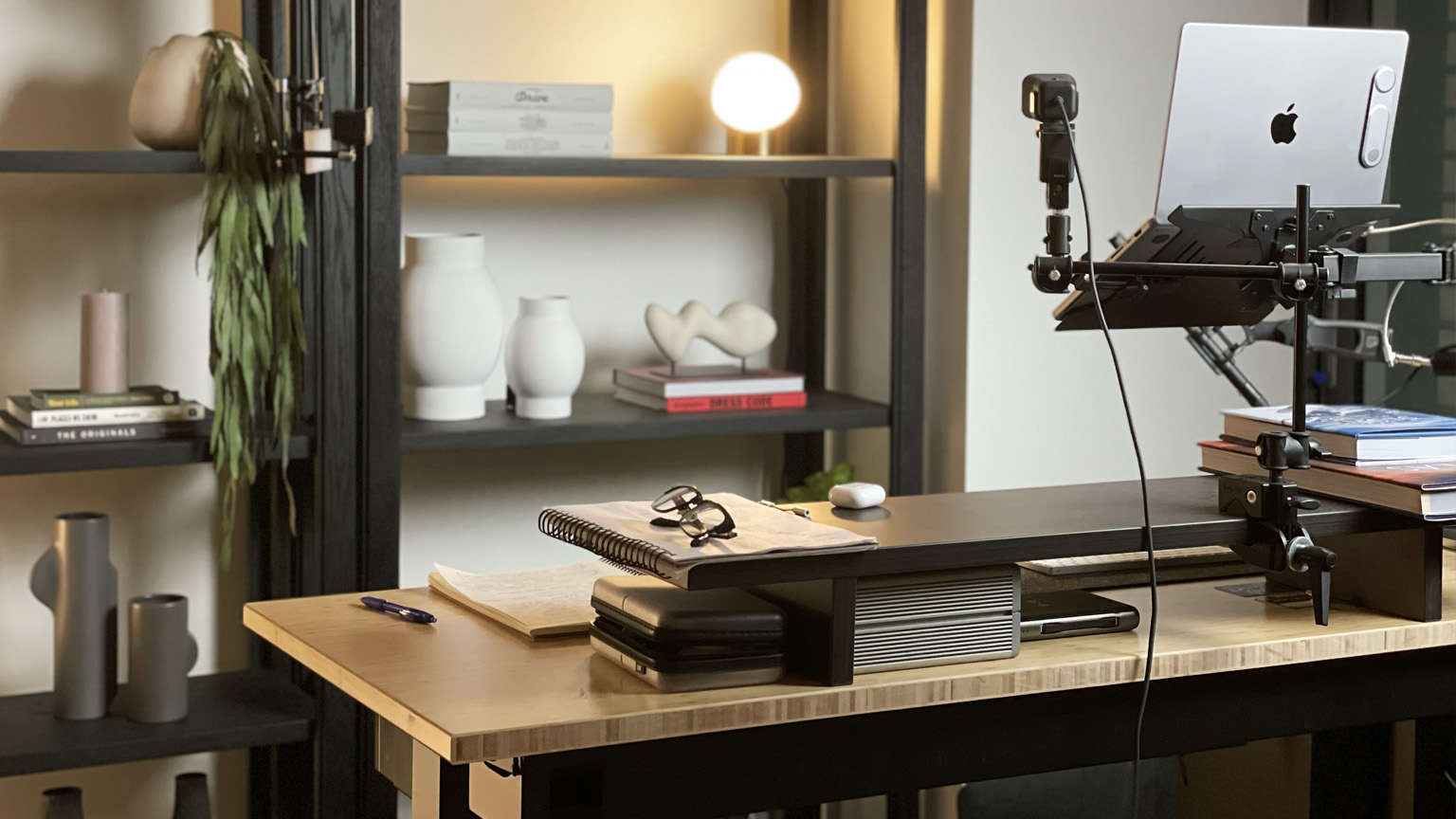
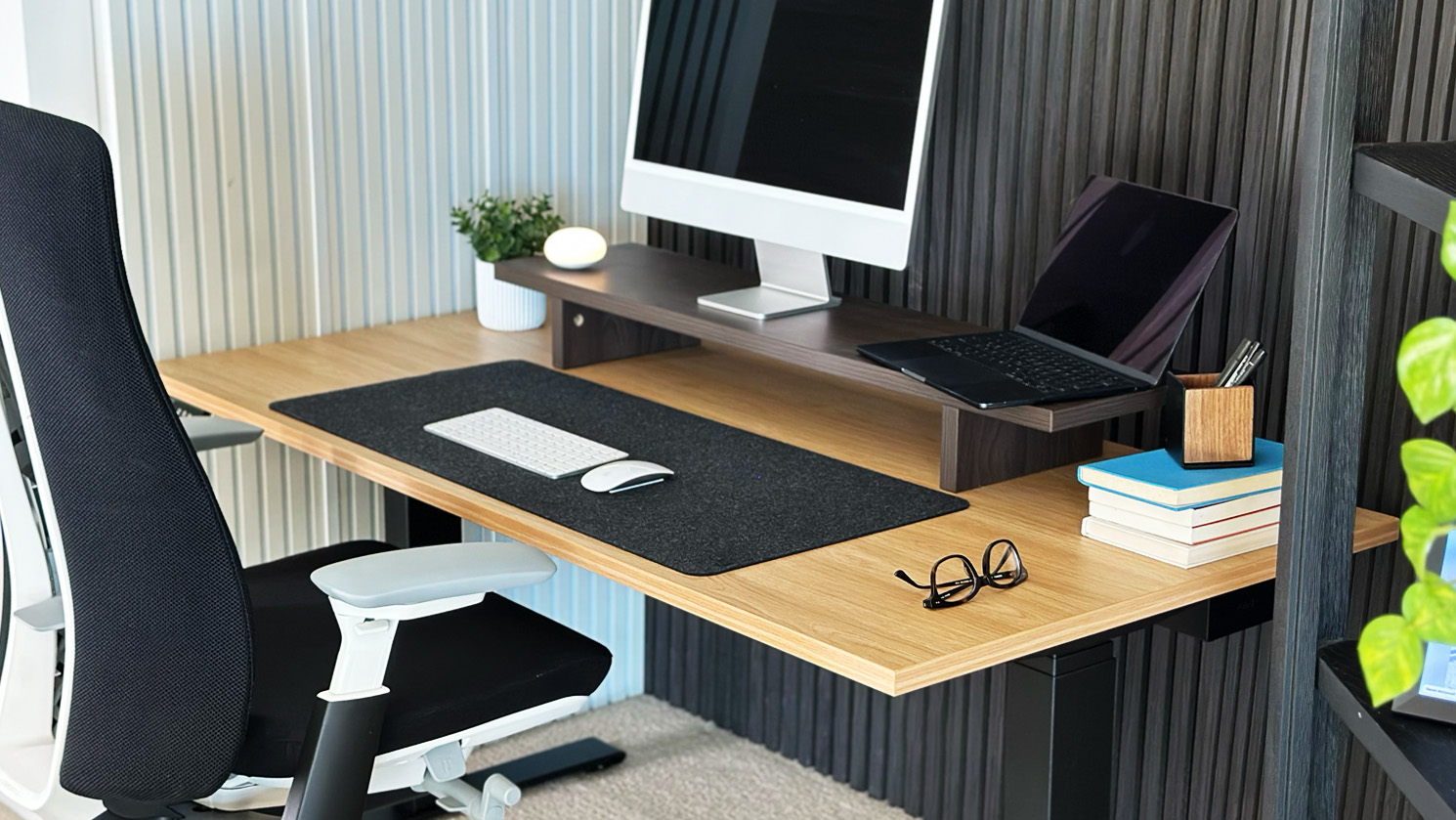

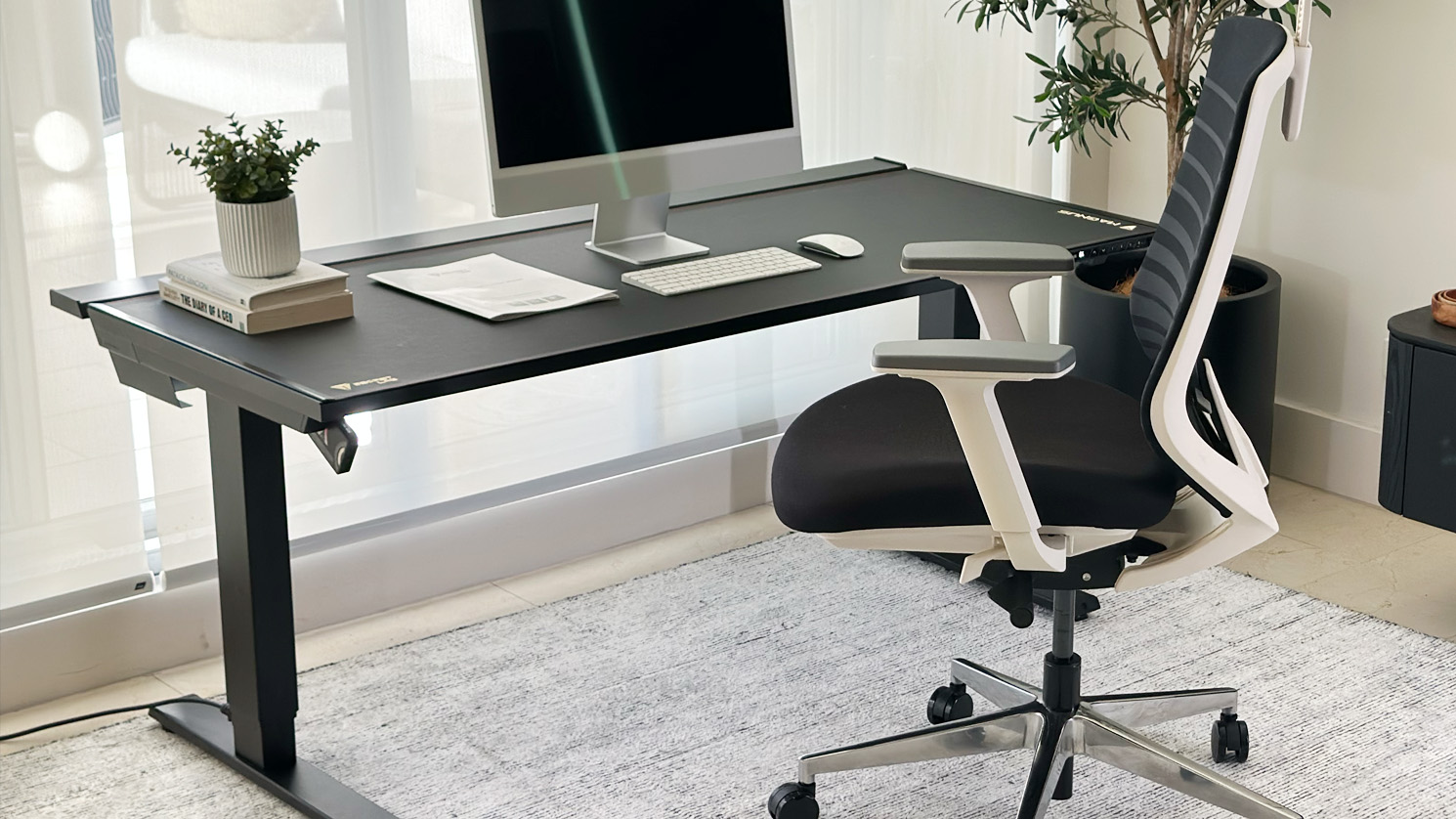


Cody says:
Hi,
Do you know 9am HOME standing desks?
I want to know how about their desk.
Steven McConnell says:
Hi Cody, I’ve never seen them before but I took a quick look for you and I’m 90% certain it’s another Jiecang desk. You can tell by the design of the feet and the lowest height (60cm). Desky, Omnidesk, Stand Desk are all pretty much the same.
Cody says:
Which one do you mean? Pesk or Robin series? I am interested in their Robin series, it looks unique and beautiful. I can’t find anyone like it in Desky.
Steven McConnell says:
I was talking about the Pesk Series. Robin series does look attractive and unusual, but I’m usually not a fan of tubular legs as they tend to be more prone to wobble. I can’t say whether this is the case in this instance, as I haven’t physically tested the desk myself. The 10 year warranty is reassuring, however. I wish they offered a risk-free trial to let you test out the legs!
Cody says:
Thank you very much, Steven; I will take your comments into consideration.
Erin says:
Do you know much about Kangadesks? There are Australian as well.
Steven McConnell says:
Hi Erin, its another Jiecang standing desk. Same as Desky, Omni, Stand Desk etc. The design of the feet and 60-125cm height range gives it away. The desk appears to currently be currently on sale for $299, which is an absolute steal and I’m wondering why they’re selling their stock at 1/3 of RRP. Regardless, even if they’re about to go bust, I’d still buy one at that price.
EDIT: Be careful. Fakespot showed these warnings while browsing their website: “Multiple eCommerce scam experiences detected, Poor customer service”
Suzy says:
Hi – given all the desks are so similar, is it possible to mix a desk from one brand with a drawer accessory from another? I don’t like the UpDown desk metal drawer (hangs very low so likely to impede leg space) but don’t mind the Desky one – can these be mixed and matched?
Thank you for the reviews! Super helpful.
Steven McConnell says:
Yes, it’s possible to play switcheroo. But you may want to consider that UpDown design is curved, so it will hurt less if you do jam your thighs into it. Desky’s meanwhile, is quite angular. Pro tip: you can also find a bunch of inexpensive slimline desk drawers on Amazon.
jason says:
I’ve spent far, far too much time agonising over which desk to get haha, definitely more than a week. Very happy that you’ve added the omni-desk to your catalogue. That was the one I was considering the most untill you came you with a review saying that it was more wobbly!
Anyways, do you have an opinion on the new updown desk KLIK Series? Its advertises to be significanlty ligher while having better (on paper) specs
Thanks!
Evelyn says:
Hi Steven, great blog post – thank you! I’m also wondering whether you have any opinion or insights on the new UpDown Desk KLIK series…they come at $100 more expensive (for the same size/table top) but seem to be ‘better’ according to the UpDown website.
Cheers!
Steven McConnell says:
Hi Evelyn, thanks! I will have a full review of the KLIK up around February 2025. It’s not necessarily a better standing desk – but it is lighter, less bulky and promises easier assembly.
Ben Clements says:
Hi. I’m interested to know more about whether I actually could fit the Desky cable management system in the Omnidesk? I’ve had a look at the omnidesks in person at the showroom and it looks like their cable management trays screw on (vs the clip in at the edges of the desk with the Desky tray). The desky system also has the power plugs that snap into place in the tray.
So I’m curious to know if you have you tried it, and if so how did you do it please? Or is your thinking that you’d just buy the power boards and plugs from Desky and rest them in the Omnidesk tray?
I’m stuck, because I prefer the Omnidesks but I really love the idea of a single power lead!
Thanks
Steven McConnell says:
I just had a new Omnidesk delivered to my house. Give me about two weeks to assemble it, test it out and report back.
Sunni says:
Thanks for your very helpful (and funny) review. I used the information to to buy a Desky standing desk in record time – no consumer agonising for weeks, as is my usual practice. It has a pneumatic up/down mechanism, so lets see how that goes.
Steven McConnell says:
Ha! You’re welcome, Sunni. Glad I helped you cut down on the agonising. The pneumatic mechanism is an interest choice – let me know what you think of it?
Amber says:
Hi Steven,
Really great and insightful review. It was refreshing to see something that wasn’t filled with ChatGPT affiliate link garbage!
I’m curious about your opinion on L-shaped standing desks? I know that Desky, UpDown and a few other retailers offer these types of desks and I would assume they are more strong and stable, but I’m not an expert and I can also imagine the opposite being true due to the irregular shape. I’ve been looking at these types of desks because I think their shape suits my space the best. Do you have any knowledge on this or do you only have experience with regular rectangular shaped desks?
Steven McConnell says:
Thanks, Amber. Did you know that I have a L-shaped standing desk review? Search for “arielle best corner standing desks” and you’ll find it.
Melissa says:
Hi Steven great article thank you!
I’ve spent way to much time on this, and I’m now leaning towards the Artiss thanks to your review.
I’m wondering if you have any insight into ergonomic chairs for the home office also?
Steven McConnell says:
Hi Melissa, thanks! The Artiss is a great budget pick. I’ve written numerous ergonomic chair reviews – Google “arielle best ergonomic office chairs” to find them 🙂
tania says:
hey are there any other manual desks apart from the ikea ones you don’t recommend, that you would recommend? I prefer the idea of not needing electricity to move between stand up and sit down but maybe that doesn’t really exist?
Steven McConnell says:
Hey Tania, all of the premium brands (UpDown, Desky, etc) offer a manual crank model. Definitely the way to go if you want to avoid electronics. But TBH I suggest you reconsider. Electronics are very reliable these days – and hand-cranking your standing desk is more annoying than you’d expect.
Adam says:
Hi, do you know much about the UpDown Klik vs Pro system?
Steven McConnell says:
The company has shipped their new Klik standing desk to me yesterday. Stay tuned!
Scott Long says:
You mention in your review of the Up Down Pro that you would get the cable holes and grommets done, but it looks like your (very pretty) Messmate desk doesn’t have them. Is your recommendation a hindsight reflection, or did you choose not to spoil the look of the desk with the grommets? Without the grommets can you can still run the cables behind the desk and into the cable management tray? Cheers!
Steven McConnell says:
Scott, I said in the review that grommets and holes are a great idea, not that I have them. They’re less important if your standing desk faces a wall. But if you have an open-plan style home office like mine, they’ll make your workspace look much cleaner. PS You can still run cables into the tray without the holes and grommets – the cables will simply run behind the desk.
Isaac Jenkinson says:
Hello,
Have you had a chance to try the new UpDown Lyft model? Curious about its stability vs the pro.
Steven McConnell says:
Isaac,
Not yet. On first glance, it looks like a budget alternative to the “big brothers”. It’s probably pretty good (UpDown has a reputation to maintain), but I’m of the opinion that buying cheap means you pay more in the long term. I’d save up another few hundred bucks and get the Pro. You can often get a melamine or bamboo-topped model on sale for around $900.
David says:
This is a great site and will help me decide on which desk to buy. Have you heard any good/bad reviews about the Blacklyte Atlas Lite or Ergo-Rise II from BDO furniture?
Steven McConnell says:
David, thanks for the kind words. Never heard of the Atlas Lite until you mentioned it. Looks like a decent gaming desk that borrows heavily from Secretlab Magnus – but why not just buy a real Magnus instead?
As for the Ergo-Rise – looks like a decent desk, but its height controller is outdated. The best standing desk brands have upgraded to OLED controllers.